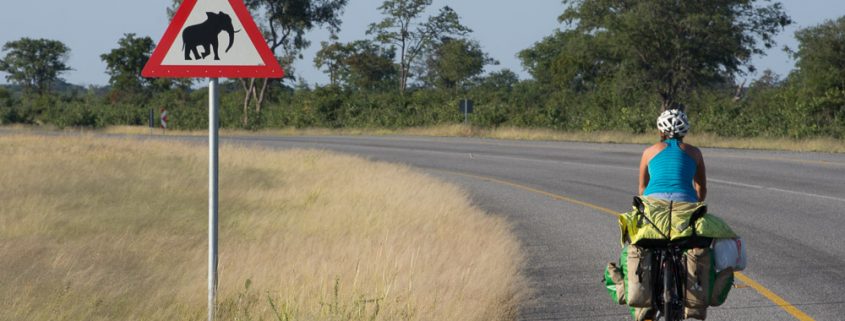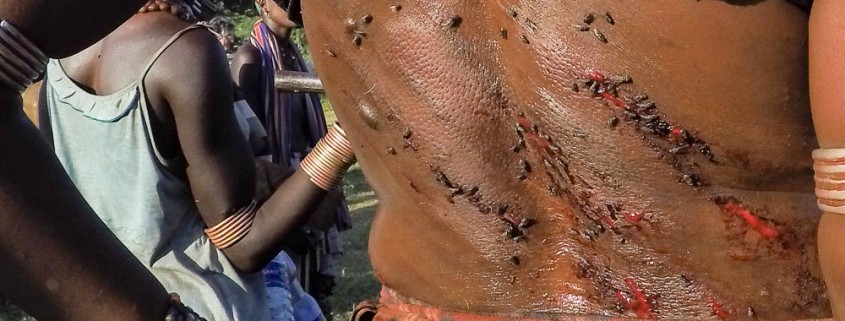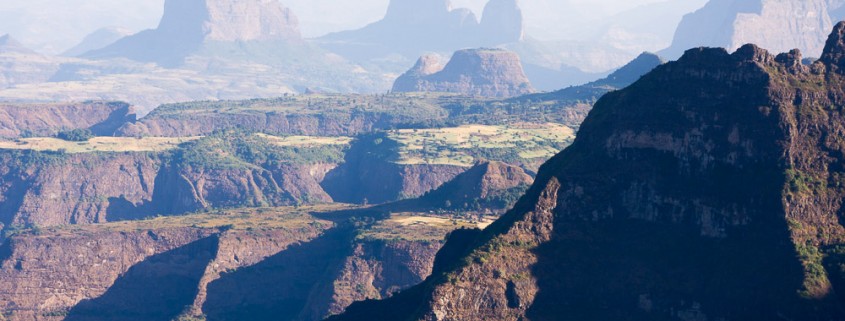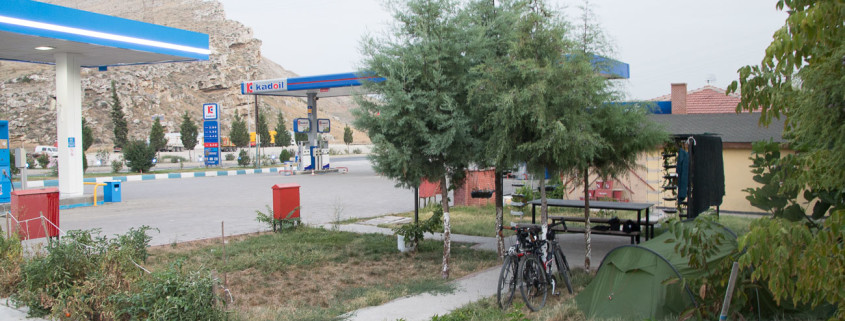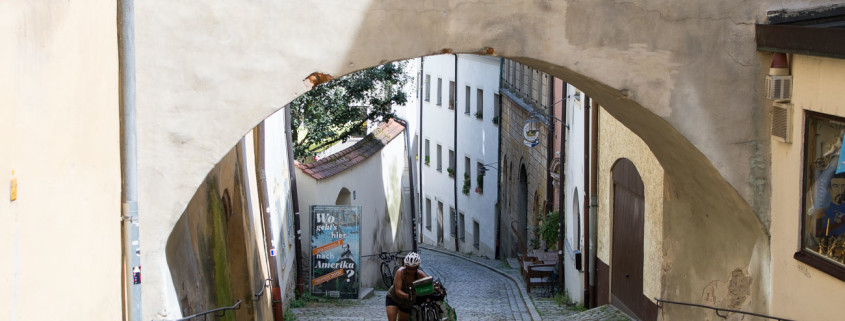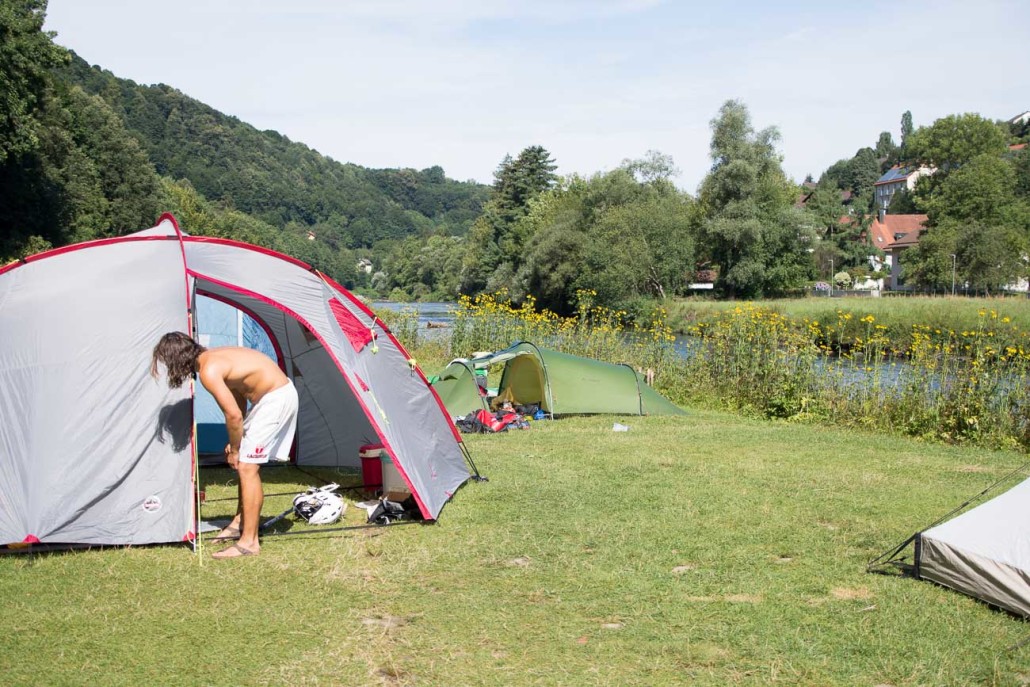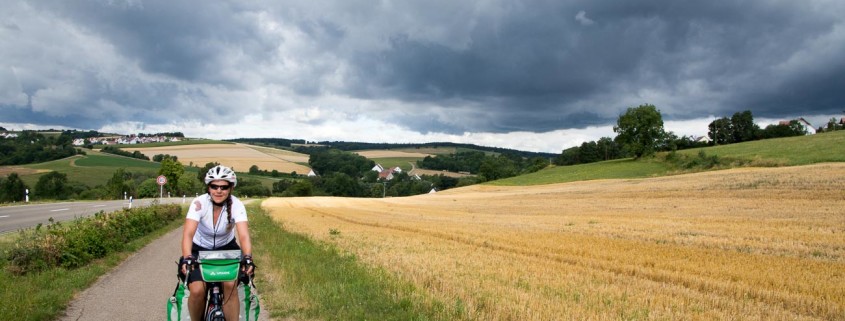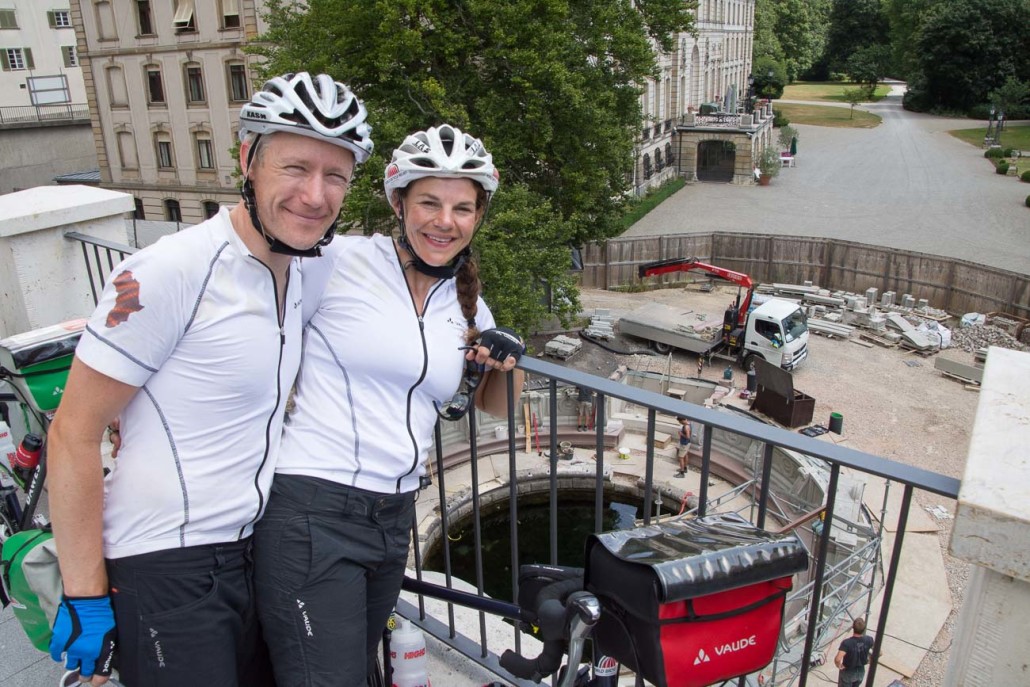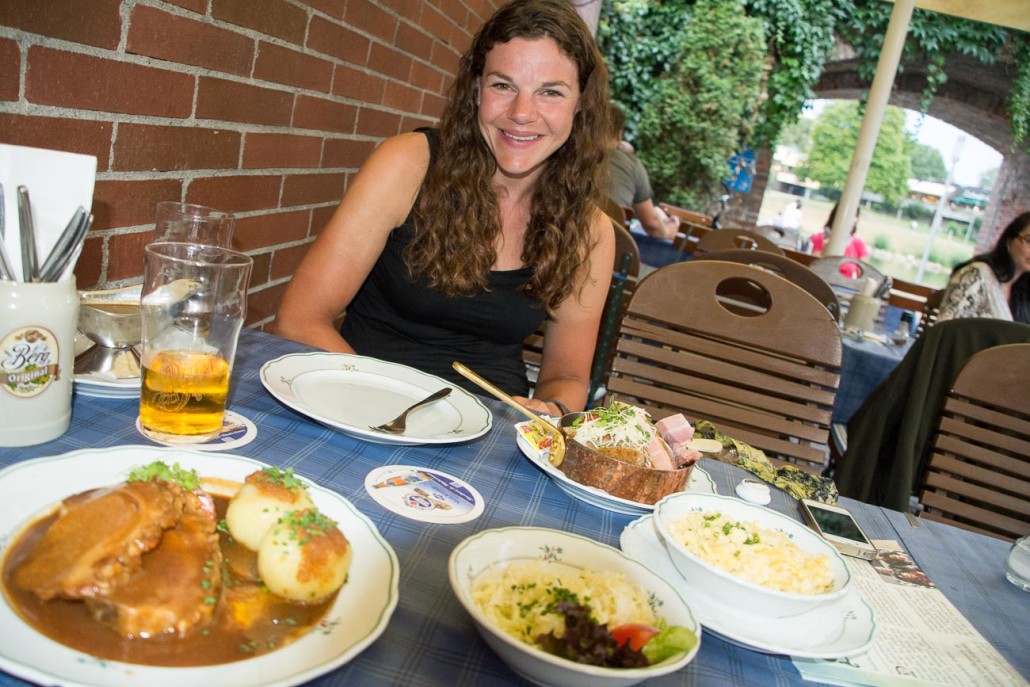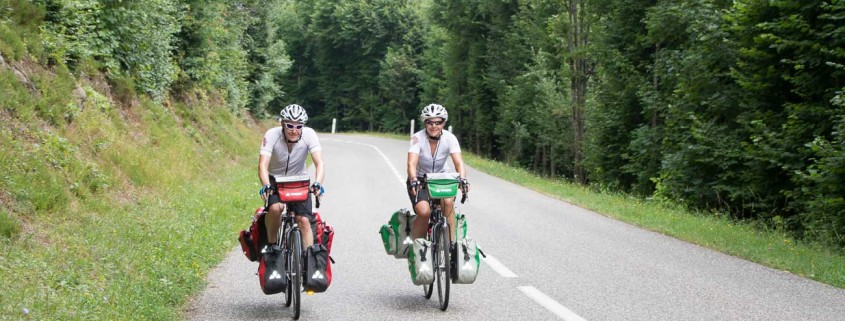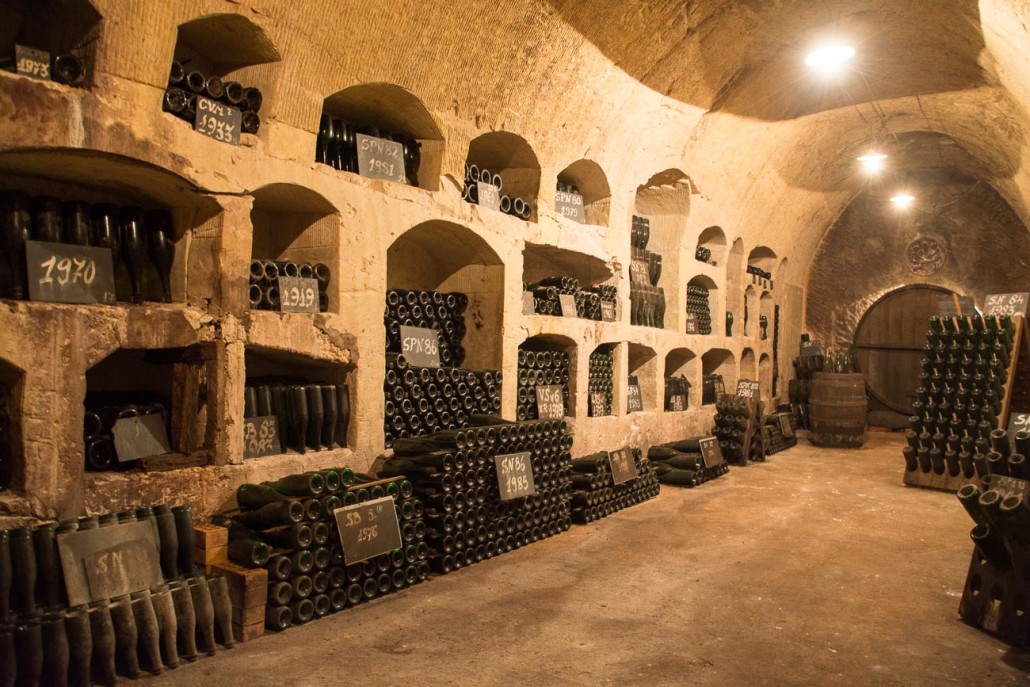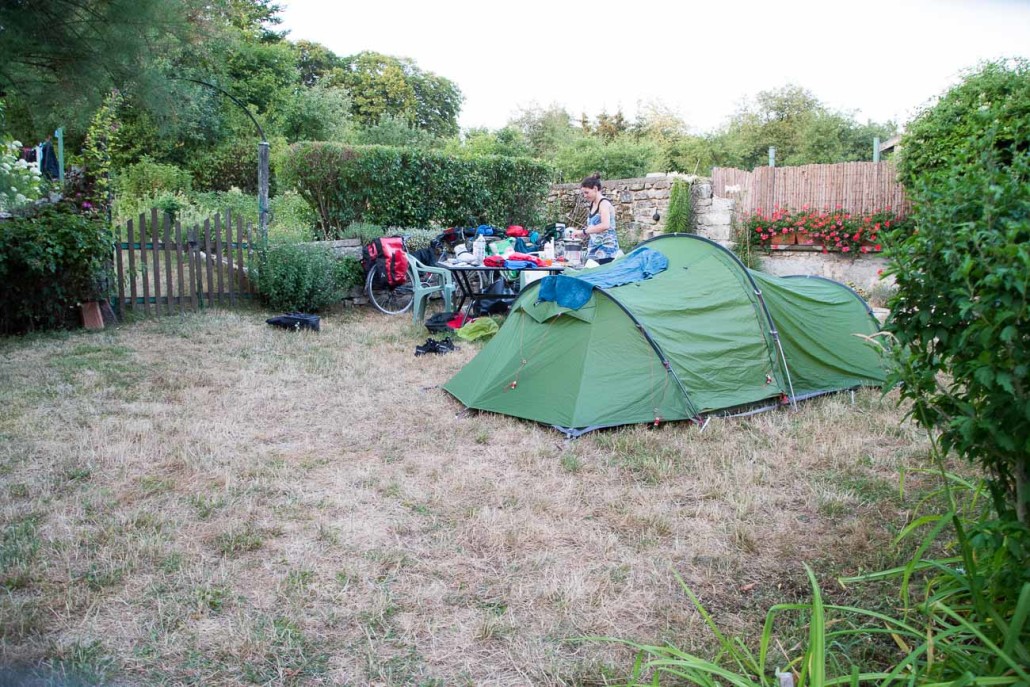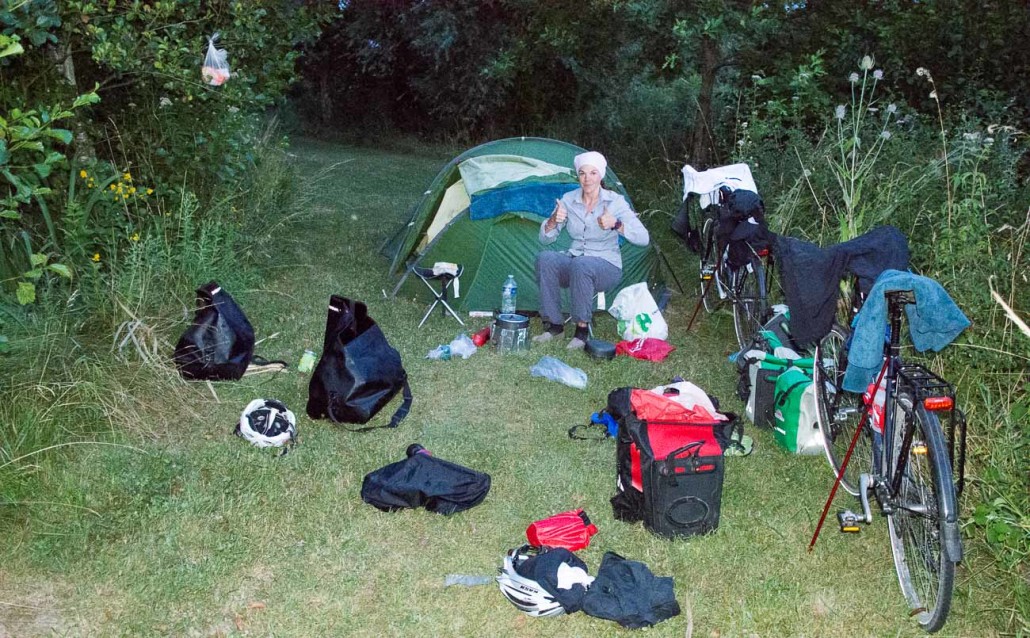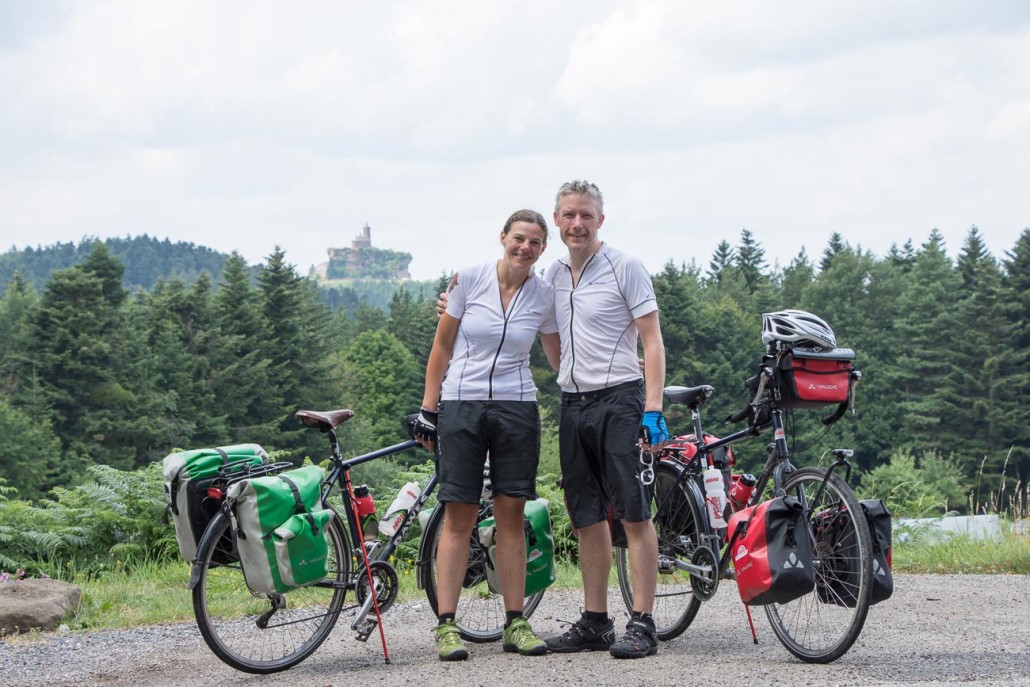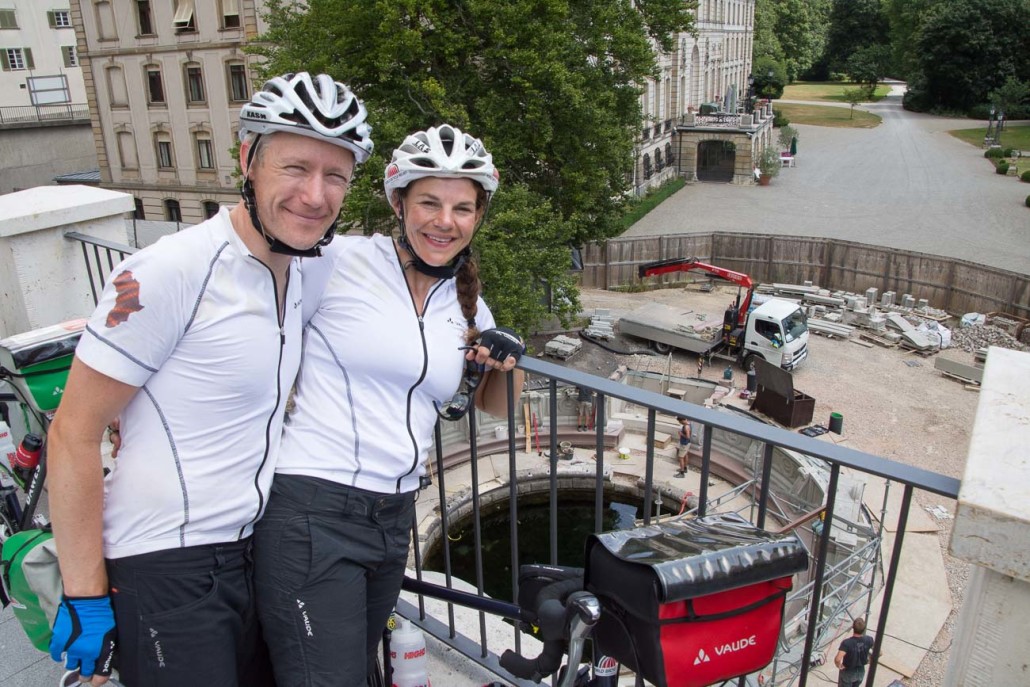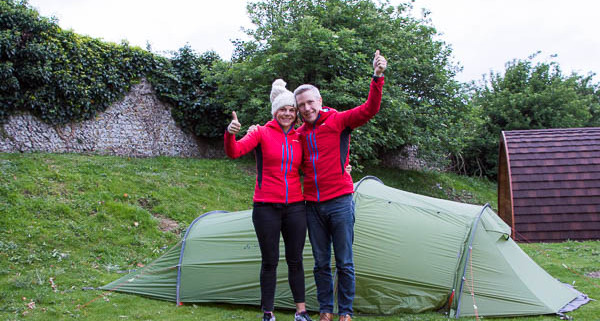Posts
Cycling the Lower Omo Valley to Omorate and on to West Turkana
/in Cairo to Cape Town, London to Cape Town /by James DavisWe would have loved to stay in Addis Ababa for Christmas. But, alas, we had to race to Kenya before our visas expired on the 31st December.
From Addis Ababa, the conventional route to Kenya is the road directly south towards Moyale. However, the first few hundred kilometers of the road in Northern Kenya is renowned for bandits and we’d therefore either have to take transport or an unnecessary risk.
Another option was to head southwest from Addis into the remote tribal lands of Ethiopia before crossing the border at the northwest of Lake Turkana in a no-mans-land between Ethiopia, Kenya and South Sudan. This route isn’t without its dangers though. But, for the touring cyclist, it offers the chance to see various tribes up close and to visit one of the remotest parts of Africa. We decided to give it a go.
Once we escaped the traffic on the road out of Addis, we had a straightforward 80km to Kela on decent road. Except, that is, for the reemergence of the children who, at each and every opportunity shouted the country-wide catchphrase of youyouyouyouyouyouy…moneymoneymoneymoney…penpenpenpenpen whilst running after us. Rocks were thrown.
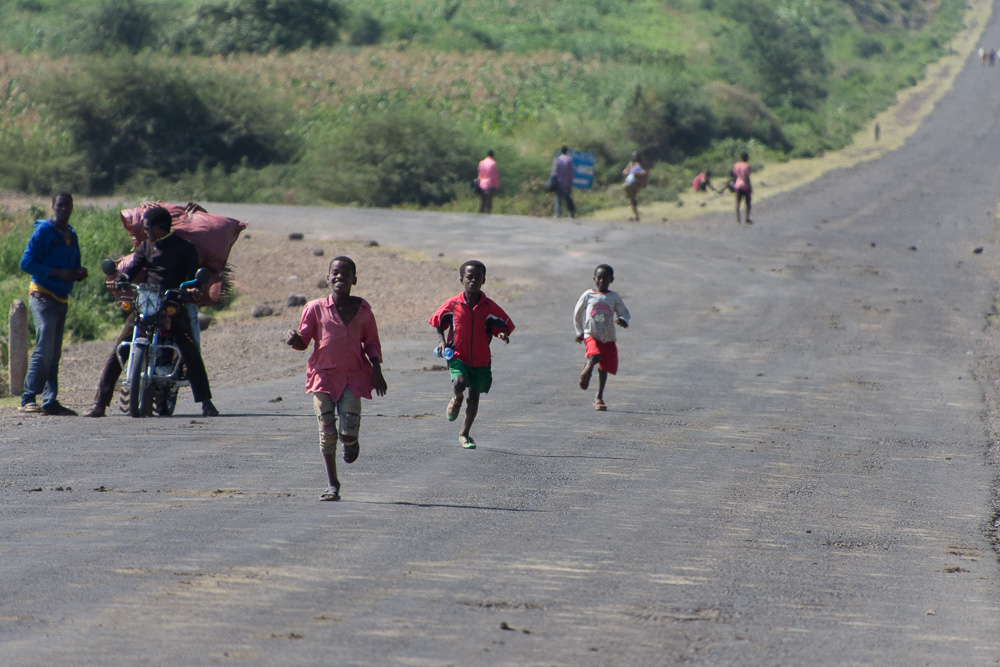
At Kela, we checked into a grotty ‘hotel’ in the centre of town. We couldn’t blame them for not having running water or a reliable power supply. But we both took exception to the turd we found in the sink of our en-suite ‘bathroom’. Luckily for the boy I made to clean it up, it wasn’t a fresh one so he was able to chip away at it until it came off the basin.
The next morning we passed through Butajira and were astonished to find a plush western-style hotel. We stopped for a cup of tea in the marble-clad restaurant and decided that, as it was Christmas day, we would find somewhere nice to stay that evening where, hopefully, there wouldn’t be any poos in the basin to greet us.
We aimed towards Hosaina where we had been promised a decent hotel and since it was Christmas Day we were extra motivated to reward ourselves with a cold beer and a pizza.
Further down the road, we looked in dismay at our intended turnoff towards Hosaina because the road was nothing but a stretch of rubble. We opted to continue on the tar road but this meant a longer cycle without knowing what the elevation was going to be like.
We didn’t think the road would be too hilly, but we were taken by surprise.
We spent 10 hours in the saddle on Christmas day. We covered 145km and ascended over 1,600 meters. All to the constant and irritating accompaniment of youyouyouyouyouyouyouyouyouyouyouyouyou, moneymoneymoneymoneymoneymoneymoneymoneymoneymoneymoneymoney and rocks thrown at us regularly. All Emily could think about all day was her new-found dislike for Bob Geldof as she spent the entire day singing “Do they know it’s Christmas?” and, perhaps unjustifiably, blaming him for the rock throwing child beggars.
Utterly exhausted, we eventually got to Hosaina and limped into the first western-looking hotel we could find. We stumped up an extortionate (550 Birr/£17 for the night compared to our usual 100Birr/£3.00 per night). But, it was Christmas and we thought we’d give ourselves a treat. The 566% increase in cost did not equate to a similar increase in service though. Although we enjoyed cool beers, a pizza and a comfy bed, we had to endure the sound of the very loud Christian Orthodox church across the road wailing all night and, at 3am, I woke the pigeon that had been sleeping in the bathroom and spent 15 minutes trying to catch it as it flapped around the room.

We had a similarly tough ride the next day to Sodo. We saw the first troop of baboons of the trip cross the road ahead of us but the day’s ride itself was made worse by the children and villagers.
As we approached each village, high-pitched screams of “Farange!” would greet us from the sidelines. These shouts rippled up the road before us until the whole village knew to expect us so they could each run out to shout youyouyou, moneymoneymoney, penpenpen and “where-you-go?” at us. With such an early warning system in place, it’s little surprise that Musolini failed to colonise Ethiopia.
At one of the larger villages, we pulled over to the side of the road and, before we could even park our bikes, people had surrounded us. By the time Em returned with two warm bottles of the fizzy stuff, she could barely find me amongst the throng of kids and adults standing, staring, playing with the bikes and asking for money.

Just before we reached Arba Minch, we met Jimmy, a French motorcyclist who was making the long journey from Cape Town to France. He recommended the Bekele Mola hotel to us so we headed there. In their reception they have a sign proudly stating that Ethiopians pay 400Birr and Foreigners pay 580Birr for a room. Camping in the grounds was 300Birr. Needless to say, we weren’t happy with the price differential so negotiated to pay the Ethiopian rate for a room. Which was lucky because warthog roamed the grounds we could have camped in. The view from the hotel’s terrace across the two lakes was stunning and more than made up for the overpriced room and food.
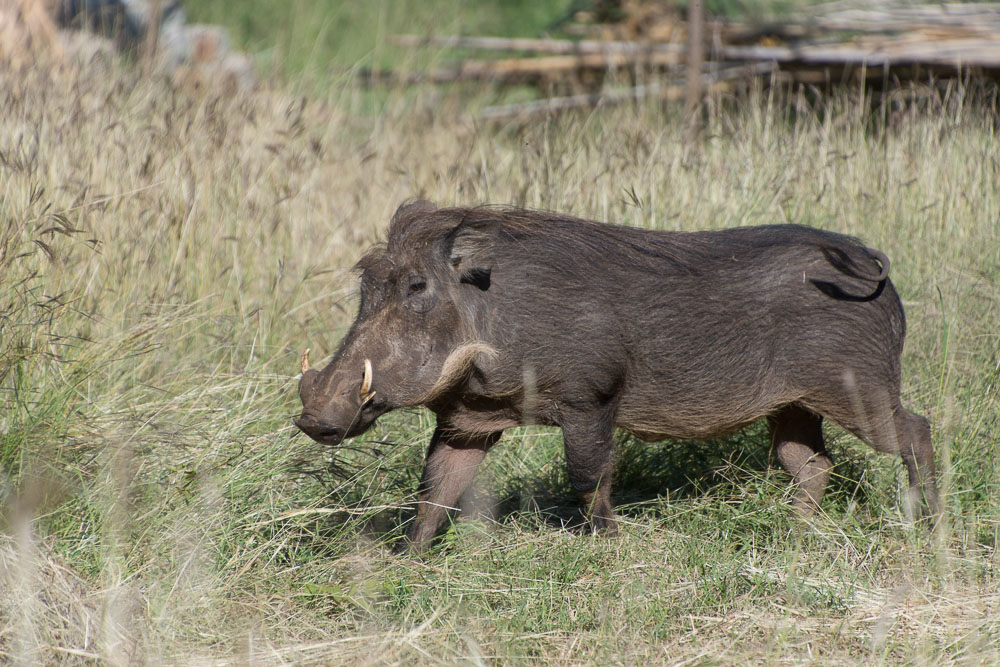
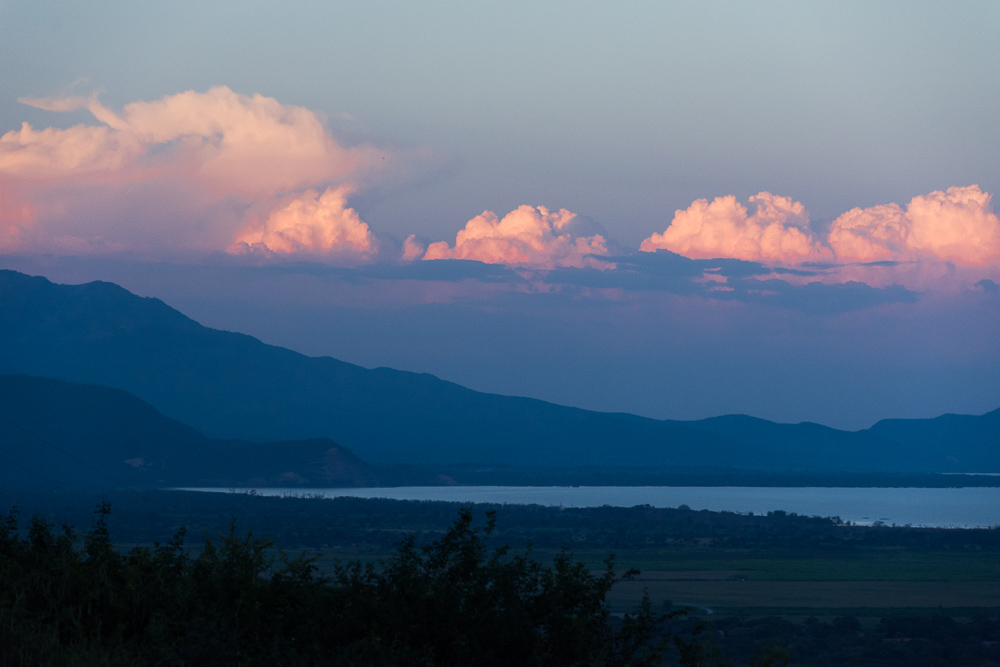
A couple of hilly days’ ride through banana plantations later we made it to Konso. We couldn’t find any decent places to stay in town so we climbed up a massive 20% hill where we’d seen a lodge marked on the GPS. With panoramic views over the countryside (a UNESCO heritage site due to the uniqueness of the hill terraces) and an expensive-looking restaurant, I thought the receptionist had made a mistake when she said it was “55 for the night”. That is, until I realised it was US$55. At that price, we had to find somewhere else to stay…which meant travelling back down the hill we’d just cycled. Thankfully, the lodge agreed to store our bags and bikes and we got a tuktuk into town.
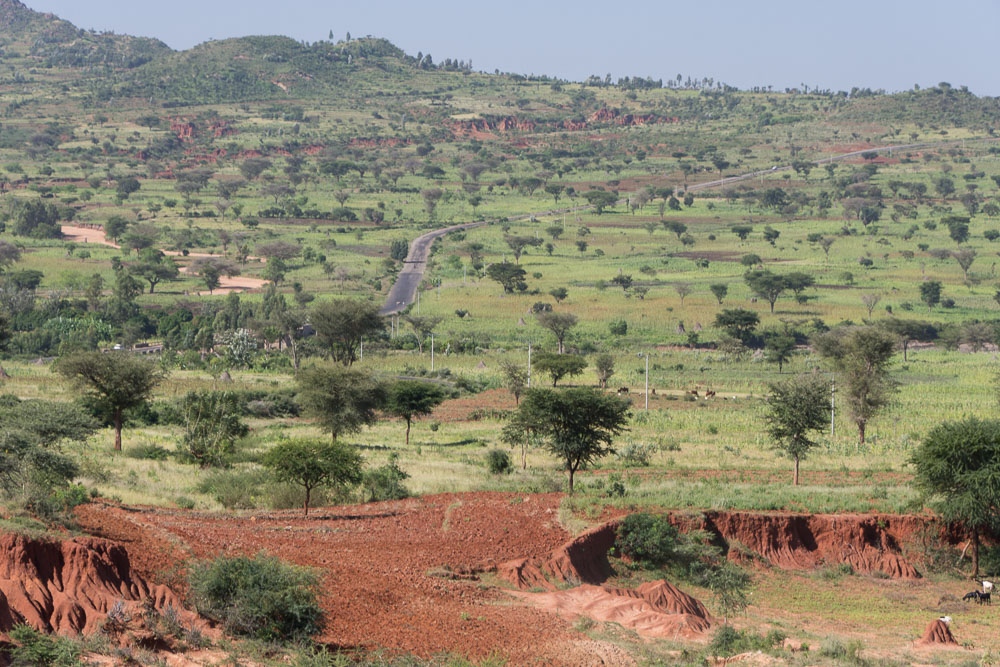
There, we found a much cheaper hotel where I negotiated the price down from 200Birr to 50Birr for the room on the condition we buy a few drinks. We had couple of beers, paid the 50birr for the room and headed into town for some food.
At the restaurant, ordering our meal was tricky. Firstly, as is common with most Ethiopian restaurants and hotels, the TV is on at full volume meaning nobody can hear anything other than the din from blown speakers.
Secondly there’s a bizarre phenomenon that’s quite unique to Ethiopia. When taking an order for food or drink, the waiter will turn on his heels after the very first item you say. It’s happened at nearly every place we’ve eaten. For example, if you wanted one spaghetti and one pizza, you’d barely be able to finish saying “one spaghetti” before he’s off to the kitchen…even though there’s at least one more dish and a couple of drinks to order.
Thirdly, it was another occasion where the waiter insists that there’s only one thing on the menu. We reluctantly order it. Later, whilst we’re eating, other diners who’ve arrived after us are brought much more appetising dishes. When we inquire, the waiter will say that’s available too. When we try to order it, they say it’s run out. I only mention this because it’s happened several times in Ethiopia!
Anyway, we had a reasonable meal and had fun meeting Harley and Emily, a couple travelling from South Africa to Sweden in their Land Rover.

Back at the hotel we were preparing for bed when there was a knock at the door. Apparently the room was now 150Birr and not the 50Birr plus beers I’d agreed. After a long ‘conversation’ I was forced to stump up the 150Birr for the privilege of the grimy room with the sound of yet another TV turned up to number 11 in the courtyard outside our room.
The next morning we took a tuktuk back up the monster hill to collect our kit and bikes. At the lodge, we met Tom and Eva, a South African couple who are travelling Africa in their huge unimog 4X4.
The cycle out of Konso was beautiful but hilly. Every inch of the surrounding hillsides was being used for agriculture in an intricate pattern of interweaving hill terraces.
Then something expensive happened.
I swooped down a lovely decent towards a bridge that crossed a partially dried-out river. What I failed to notice until it was too late was a 15cm ‘step’ right across the width of the road where the bridge joined the tarmac road.
I tried to bunny hop, but with a combined bike and rider weight of over 150kg, I could just lift the front wheel enough for it not to take the full force of the collision. The impact was hard. And a sickening crunch rose up through the wheels, into the frame and into my bones as I collided with the obstacle. I just managed to keep control of the bike and avoided a crash but I was helpless to stop my handlebar bag fly open and all I could do was cling on as I watched my beloved Nikon DSLR camera and various other bits of tech hit the asphalt with an expensive smash.
To their credit the kids hanging around the bridge quickly gathered up all the broken parts and handed them back to me. The camera was dead. I was gutted because of the remote and photogenic region we were to cycle into. But, with no obvious signs of damage to the bike and no injuries, the journey continued.

A short while later, Tom and Eva passed and handed us ice-cold waters from their huge vehicle. After the hot water we’d been sipping from our bottles all week, the crisp coolness of fresh icy water was like sipping vintage champagne.
Tom said they were headed to a campsite 75km away. It was 1pm and 75km in an afternoon is quite punchy for anyway but, with Tom’s promise that a cold beer would be waiting for us, we decided to give it a go.
At Woyto, there’s a junction. The asphalt road continues on a longer, potentially hillier road towards Omorate. The turning left is on a hard-packed rough road but it’s shorter. We met Christian, a missionary form Iceland who was visiting friends in the area. He advised that the shorter but unsealed road was best for us. We took his advice and I lead the pace on what Emily called “James’s Omo Valley Training Camp”. Tom’s ice-cold beer was a big carrot dangling in front of me!
Our chosen road took us across the Lake Stephanie Nature Reserve. Lake Stephanie is dry pan but recent rains had caused an explosion of green in the otherwise arid landscape. Butterflies danced beside roadside ditchwater and crickets played a game with us by jumping ahead – always managing to keep at least a meter ahead of our wheels.
The road was rough and there was no way we could make Tom’s campsite. Instead, we stopped at Abore, a tribal village where hundreds of well-behaved kids came out to greet us. A friendly chap called Simon lead us to the water pump where we filled up and then to a small bar where we bought him a Coke and met another guy who was a guide from Konso. He invited us to camp with him in the bush that night.
We pitched our tent amongst several straw huts and chatted to some of the tribe who lived there. The women wore hundreds of stacked neck beads and the little children had painted white faces. They were all very friendly and accepting of our intrusion into their normal life and not a Birr was asked for. We drifted off to sleep to the sounds of traditional singing floating across the bush from a nearby camp knowing that this was a true African experience that we were incredibly lucky to have.
We’d established from the guide that Tom’s “75km to the campsite from the turning” was somewhat inaccurate. In fact, it was 75km from the village in which we were camped. We set off early to get there.
The road conditions were awful for cycling. There were countless dried up creeks that crossed the road so we couldn’t get any rhythm going and had to keep dismounting to push through the sand. Progress was slow and exhausting.

In the afternoon, we had 30km more to travel but the road disappeared altogether. Instead, we had to haul our heavy bikes through the sand of a dried-up riverbed and then up a 15% track that was nothing but loose sand and rubble. At times the road was so steep that we had to push one bike together up the hill and then return for the other, as it was too steep to push alone. How we regretted not taking the asphalt road and kept remembering the words of the Icelandic missionary who categorically said to us, “It’s not that bad at all, there is a small hill but you should be fine.”

For 8 hours we didn’t pass a single village. There were very few people. Of those we did see, some ran off into the bushes upon spotting us. Those more inquisitive folk would return our waves. All the males had little hand-carved stools which they carried everywhere with them. The tribal people seemed more mild-mannered and for us, seeing rifles harmlessly slung over shoulders rather than fast approaching rocks was a relief.
We were exhausted and dehydrated having pushed up over 1,200 meters of ascent through sand and rocks. At 4pm, we saw the first vehicle of the day. They stopped and, when they told us where they were going, we simply could not refuse their offer of a lift.
We joined Rokhan, who was on holiday from Sri Lanka, his guide and driver for a 10km drive deep into the bush where we witnessed one of the oldest and most bizarre tribal ceremonies. The Jumping of the Bulls.
The woman couldn’t have been older than 25. She blew her horn. The man facing her raised his whip and with almighty force thrashed it across the woman’s bare back. The whip tore into her skin. The woman bowed towards the man. Again and again this happened. Each time, the woman would take a single hard lash across the back. It must have been agony. But she barely flinched.
We learnt that, as part of the ceremony, the women beg to be whipped as a sign of their love for the man. It might be the male’s mother, sister or niece taking that takes the beating.
The women of the tribe then stand in a circle, backs towards us. We saw blood dripping from the open wounds. Flies landed, looking for somewhere to lay eggs. The scars of previous whippings were evident.
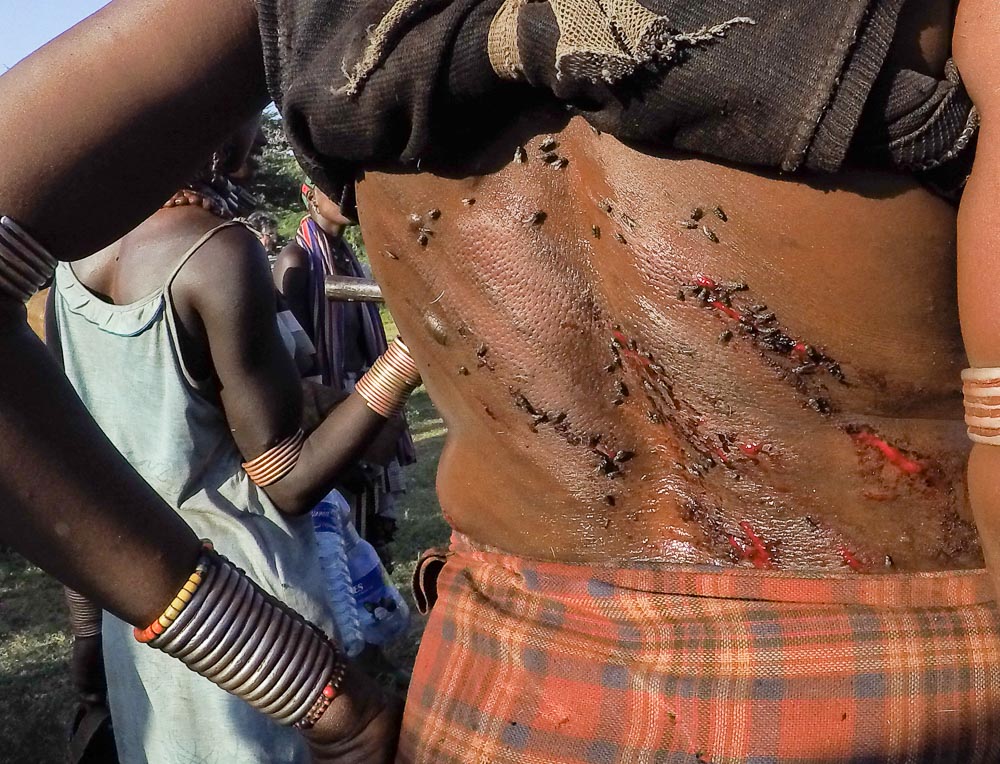
We were on to the main event.
Several bulls had been let into the field. About 8 bulls had been pushed, prodded, yanked and twisted so that they were now standing in a line. A naked man edged backwards, eyeing up the task ahead. His challenge was to leap up and run across the backs up the bulls without falling into the gaps between. If he succeeds, it marks his passing from boy to man.
He took a run up and jumped up to the first bull that reeled from the impact of the chap’s foot on its flank. He then skipped across the moving obstacles before losing his footing just short of the final bull. He repeated this 6 times. Everyone cheered and he was adorned with a garment for his neck. He was now a man…and so started 2 days of celebrations.
It was now sunset. Rokhan’s driver dropped us off the short distance to our campsite near Turmi where we finally met up with Tom and Eva at their Unimog. They cooked us a delicious pasta meal and we thoroughly enjoyed their company…and that ice-cold beer that we had suffered so much for.
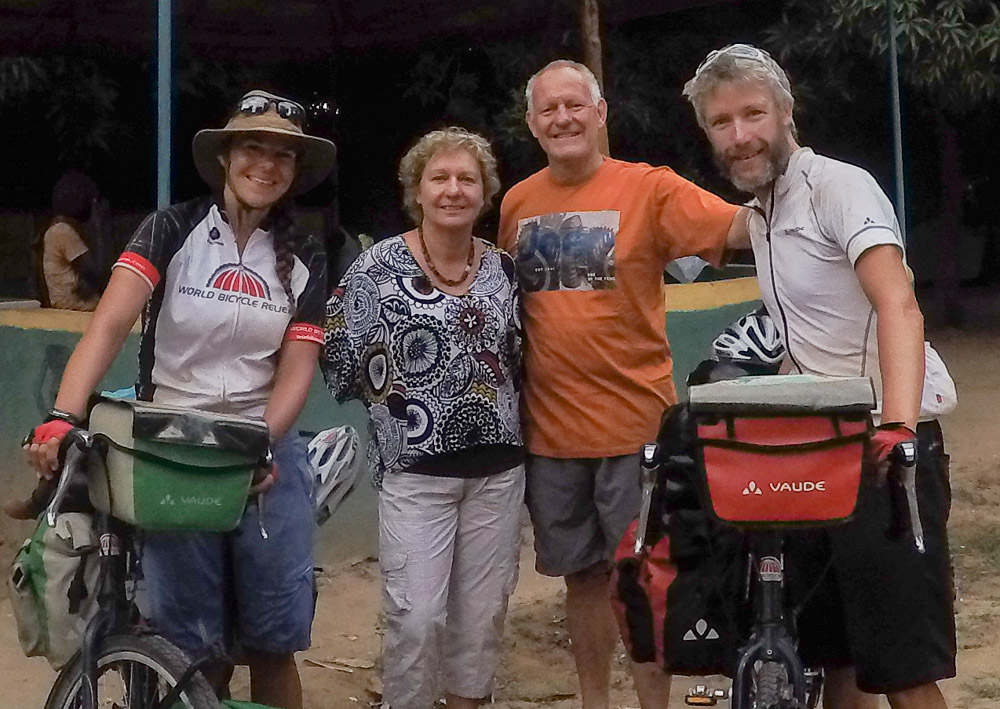
It was a relief that the 50km from Turmi to the final town in Ethiopia, Omorate was a gentle cycle on beautiful smooth tarmac. We headed to the immigration office where we had to guide the official, who was clearly drunk, through the process of stamping our passport with an exit stamp with the next day’s date. The process took a while because he couldn’t get his fuzzy head round the concept of our visa being valid from the ‘date of entry’ rather than the ‘date of issue’ which he was insisting was the case. He claimed we were in the country illegally and threatened to take us to Addis Ababa. We were there for over an hour before his desire to return to the bar took over and he finally stamped our passport.
Omorate doesn’t have anything to offer. Not even electricity. And we even struggled to stock up on food for our journey into Kenya. But we did manage to get a friendly chap to charge our Goal Zero Sherpa 100 power pack so we could ensure our GPS would work for the journey ahead.
We’d heard many tales from other travellers that crossing the bridge over the Omo river is an issue. Policeman guard it and insist that it’s closed, despite locals walking across it, forcing travellers to pay for a boat or dug out canoe across the river.
When we approached the bridge, we could see the police guards and, from the distance, they were waving us back. We continued and, just as we approached them, a big pickup truck thundered up on to the bridge from the opposite bank crossed over and passed us. There was no way the police could claim that the bridge was closed now. They made a cursory check of our passports and to our relief, we cycled over the bridge.
Once we were on the far bank, our challenge was to negotiate a confusing network of sandy tracks towards the Ethiopian army checkpoint then through the arid no-mans-land before getting to the Kenya border checkpoint.
This was hot, dry and the sandy conditions of the road made cycling impossible. The weight of our bikes, now even heavier with the weight of 10 litres of water each and food supplies for up to one week, cut straight through into the sand causing a few low-speed crashes.

We had to haul our bikes through the sand. It took us 4 hours to make the 29 kilometers from Omorate to the Ethiopian army checkpoint. The friendly squaddies offered us water and we relished the shade. But we had to press on.
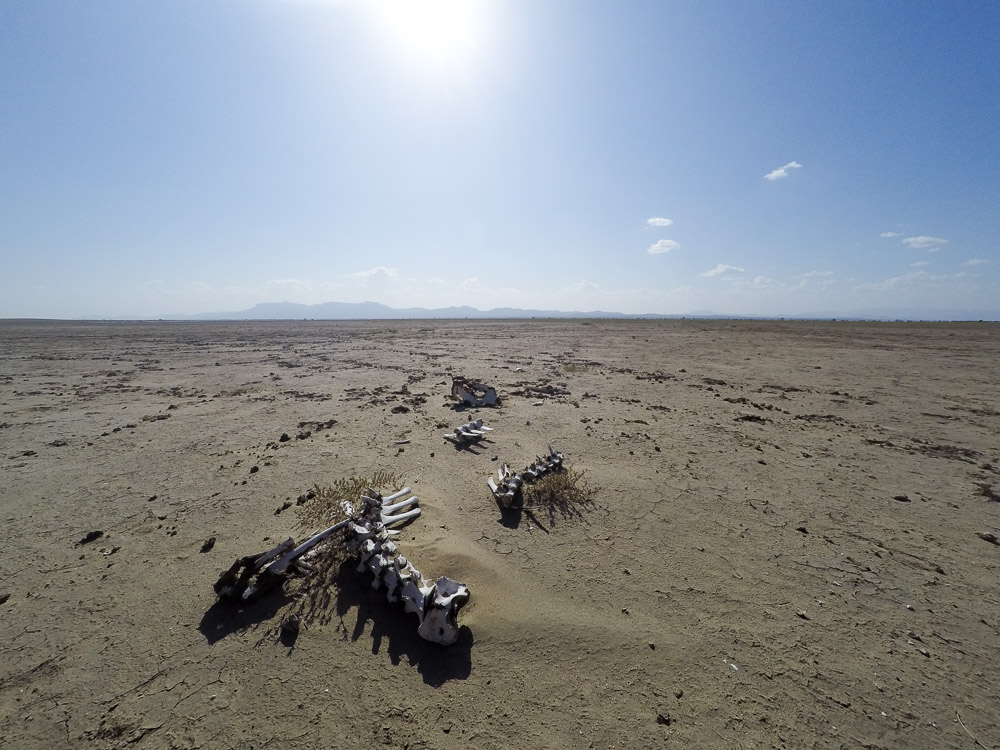
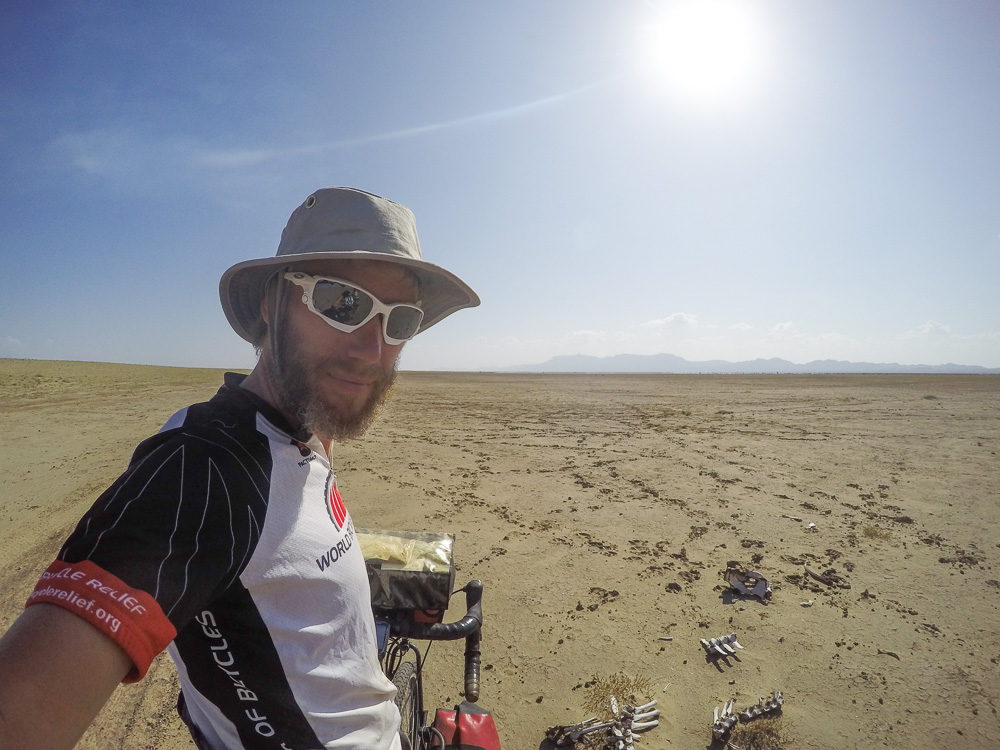
It took us a further 2 and a half hours to haul our bikes through the sand over the 7km between the Ethiopian and Kenyan border checkpoints. We arrived exhausted.
The Kenyan policeman took our details down in a book (we couldn’t get our passport stamped because it’s not an ‘official’ crossing) and invited us to pitch our tent at the police compound. Another policeman told us that the road onwards would improve and stamped his feet on the hard-packed surface of the police compound, suggesting that that was what we could expect from now on. By now it was 5pm. The sun would set in 90 minutes. We were knackered but decided to press on. It was just 10km to get to our intended destination.
Sadly, the policeman’s description of the road ahead was entirely inaccurate. Once again we were forced to dismount and heave our bikes through the sand.
As the sun went down behind the distant mountain, we were forced to call the day’s ride to an end – just 3km from our target destination. We camped in the bush amidst billions of mosquitos and insects. Later that night, I discovered that the flying sharks had attacked my back by biting straight through my shirt. Emily lost count at over 100 bites. Not great when we’re in a malarial area and aren’t taking prophylactics.

Since leaving Addis Ababa, we’d been on the road for 10 days straight – our longest period without a break. The terrain had been hilly. The kids were horrendous. We had rocks thrown at us several times a day. We’d been munched by mosquitos. The roads had petered out and turned into riverbeds. We’d had to haul our bikes through kilometer after kilometer of sand. The mercury topped 50 degrees on most days. All this had put a huge toll on our bodies and has triggered a few medical issues. We needed a break. We needed a refuge. And we found that just 3km up the road the next morning at the Our Lady Queen of Peace Catholic mission in Todonyang – the first town in Kenya.
We were greeted warmly by Father Andrew, pitched our tent under a tree and brought cold, crisp water by a charming chap named Cosmos. Father Andrew told us that the road between the mission and Lodwar was the same sandy surface we’d suffered.
It would have taken us 7 to 10 days to travel the West Turkana route by bicycle. And we would have had to haul our bikes through the sand and more dried riverbeds. Something we didn’t have the health to do. The next day, we strapped our bikes to the top of the 4×4 and joined Father Andrew (as he drove like a man on a mission) and friends for the incredibly bumpy and uncomfortable trip to Lodwar, where we are now. En route we saw a monument that marks the spot of the oldest skull to have ever been found. Turkana Boy.
We shall make up the miles we missed. In Lodwar, we’ll get ourselves checked out by doctors and speak to the police about the security situation on the road ahead. The long and lonely road between Lodwar and Kitale is renowned for bandits and tribal conflict so we need to get up to date advice on what to expect. Should we need to bypass this section we’ll make those miles up too.
Ethiopia has been an immense challenge that’s left us both utterly exhausted. It’s a beautiful country. But it’s incredibly difficult cycling over such terrain and, despite some magical experiences in the tribal lands of the Omo valley, enduring the constant ‘difficult’ interactions with the people. I’ve found the country has brought out an angry side in us at times. I’ve lost my temper of numerous occasions in situations where I’d normally be mild mannered. When rocks have been thrown at us by children I shamefully admit to returning a few of them with interest. It’s an anger that I’m leaving at the border. And, once we’re fit again, we’re both hugely excited about the journey ahead in Kenya and into Uganda where we expect to be cheered rather than jeered. And where a cold bottle of water is, hopefully, only a village away.
Walking back to recovery in the Simien Mountains, Ethiopia
/in Cairo to Cape Town, Kindness of strangers, London to Cape Town /by James DavisWe reached the Sudanese border town of Gallabat at 11am and found shade in the café nearest the border post. The incredibly friendly café owner refused to accept payment for the Cokes we’d plucked from the fridge and he even gave us a couple of bottles of water. We obviously looked in a bad way.
We then went through the border crossing formalities. First we visited the security department where the chap wrote our passport information down. We were then escorted to Sudanese customs where another chap wrote our passport information down in a dusty book. Then, we wheeled our bikes round the corner to another building which housed the Immigration Department. Once we’d filled out a form, handed over photocopies of our passports we received the stamp in our passports allowing us to leave Sudan.
We didn’t do so immediately.
We headed back to the café where we’d intended to spend our last Sudanese pounds. I raided the fridge for bottles of water and drinks for our onward journey but, once again, the café owner refused payment saying we were visitors in his country and he wanted us to leave with a good impression. We were just meters from the border with Ethiopia and it was, yet again, an outstanding last-minute example of the hospitality that we’d experienced throughout Sudan. Although, ironically, when he offered to change money he gave us a horrendous rate.
Once we’d been stamped into Ethiopia the next stop was customs. We were directed to what looked like a bus shelter where a couple of bored looking chaps asked us to empty the contents of our panniers.
The customs post was in a public area and people were milling round. I wanted to ensure the chap was a bone fide customs employee before he started rifling through our things but he couldn’t produce any ID. Instead, he stood up and put on a high vis jacket, insisting that this was sufficient proof that he worked for customs. In return, I reached into my pannier, took out my high vis vest and declared to him that I now worked for customs too. It raised a laugh…and a short delay as he went to find someone more senior to prove that this roadside shack was official customs.
The world changed once we’d crossed the border into the Ethiopian town of Metema.
The dusty high street leading up the hill from the border is lined with seedy bars and shifty looking folk – all looking to make a buck from whomever they could. We cycled slowly up the hill, witnessing a bar brawl on the way and debated whether the hostesses’ main employment was from bar work or employment of a more ‘behind-the-scenes’ nature. We read online that Metema was the centre of the people-smugglng trade.
We’d made the decision to take the bus to Gonder because Emily was unwell. We found the bus station and negotiated room on a bus for 100Birr (£3GBP) per person plus another 50Birr for each of the bikes.
Our trusty steeds were hauled on top of the Toyota HiAce minibus and strapped down with string. After a 2-hour wait for the bus to fill up, we departed Metema and clung on whilst we whizzed through the dramatic countryside towards Gonder – every clonk from the roof making us wince as we envisaged gears, disk brakes and frames being bashed with every pot hole.
If Metema was a shifty introduction to Ethiopia, then Gonder was the complete opposite.
After months cycling in the Muslim world it took a bit of time to get used to the things that we’d once considered ‘normal’. Smiling couples walked hand in hand. People enjoyed cool beers at roadside bars. Restaurants offered full menus with ‘farangi’ food: chips, pizza and spaghetti. The bread was raised…and delicious and the fresh mango juice was everything we had dreamt of whilst cycling in the desert.
The Muslim call to prayer was replaced by full Orthodox Christian services being blasted from the speakers of the nearby church. The Sunday morning service started at 2am and was still going strong at 8am.
Even the time in Ethiopia is different.
We’d read about ‘Ethiopian time’ before we arrived but thought it was something similar to Welsh: talked about but nobody knows anyone who actually speaks it. In fact, Ethiopian time is incredibly logical. The day starts at dawn. An hour after sunrise is 1 O’clock. 2 hours after sunrise is 2 O’Clock and so on until sunset, which is 12 O’clock. We had to make sure that any time given to us was ‘farangi time’ (meaning foreigners’ time).
We took a couple of days in Gonder to let bodies recover. And, with the cooler temperatures, great food on offer and large, comfy beds we were both fit enough for the next challenge: a 4-day trek in the Simien mountains.
We’d considered arranging our trip to the Simiens independently. It’s possible to do so but takes a few days to organize all the requirements: Transport, entrance fees, scout etc. Instead, we opted to let a professional take this pressure off us. And we’re glad we did.
Early in the morning (just as the Orthodox Christian service was finishing!) a minibus rocked up which contained our guide, Desu, a driver, a cook and an assistant cook. We picked up our scout in Debark, an hour’s drive away and then headed up the off road track to the mountains.
It’s a requirement to have a scout accompany any visitors to the park. The scout’s job is to carry a gun and shuffle behind the group for ‘protection’. There’s nothing, actually, to protect against (either people or animals) so it’s widely acknowledged that the park’s insistence on an accompanying scout is for job creation. It transpired our scout was actually a local farmer and scouted to top up his meagre wages – something we were happy to facilitate.
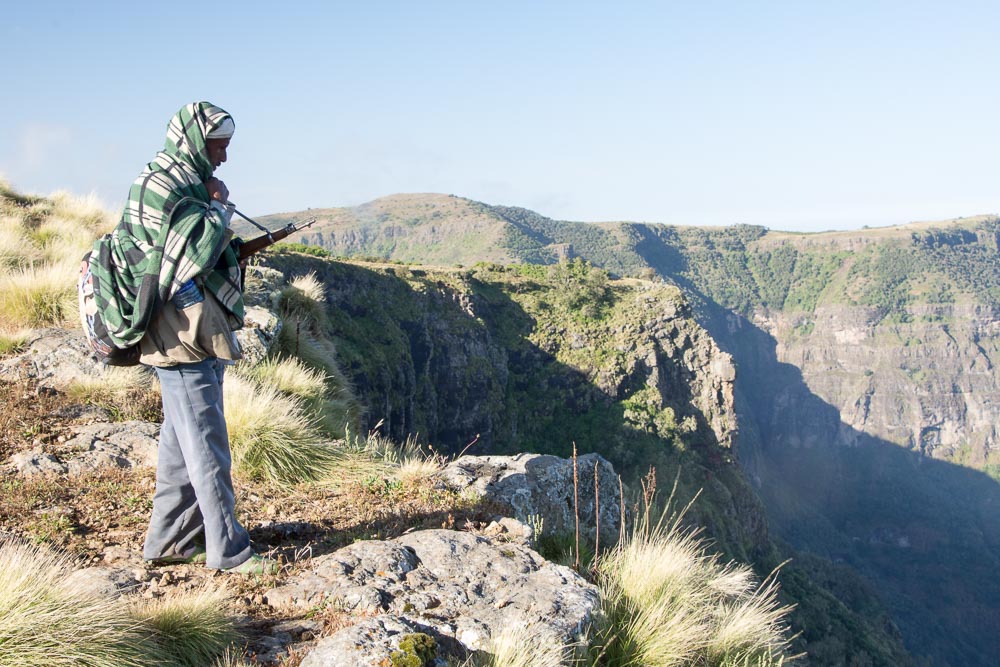
Our scout kept watch over us for four days
We laced up our Zamberlan trail shoes and, over the next 4 days we were treated to views like we’d never seen before. The paths clung perilously close to the cliff tops. And afforded us stunning views across the Ethiopian Highlands. But one small slip could have had us plunge thousands of feet off the sheer cliff face.

Trekking the Simien mountains: The World’s best ridge walk?
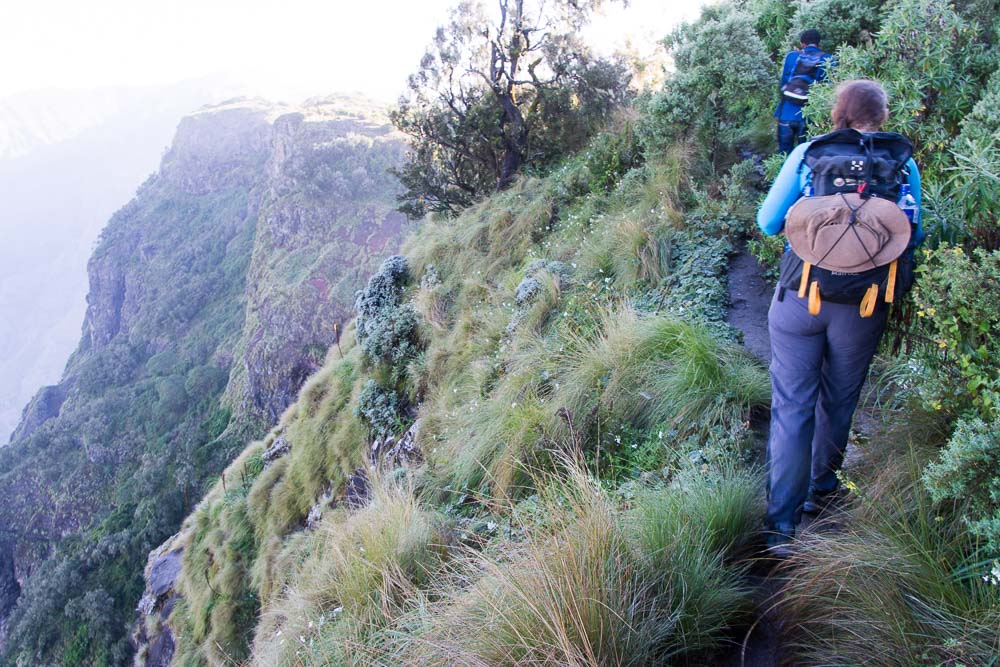
The path clung to the cliff face
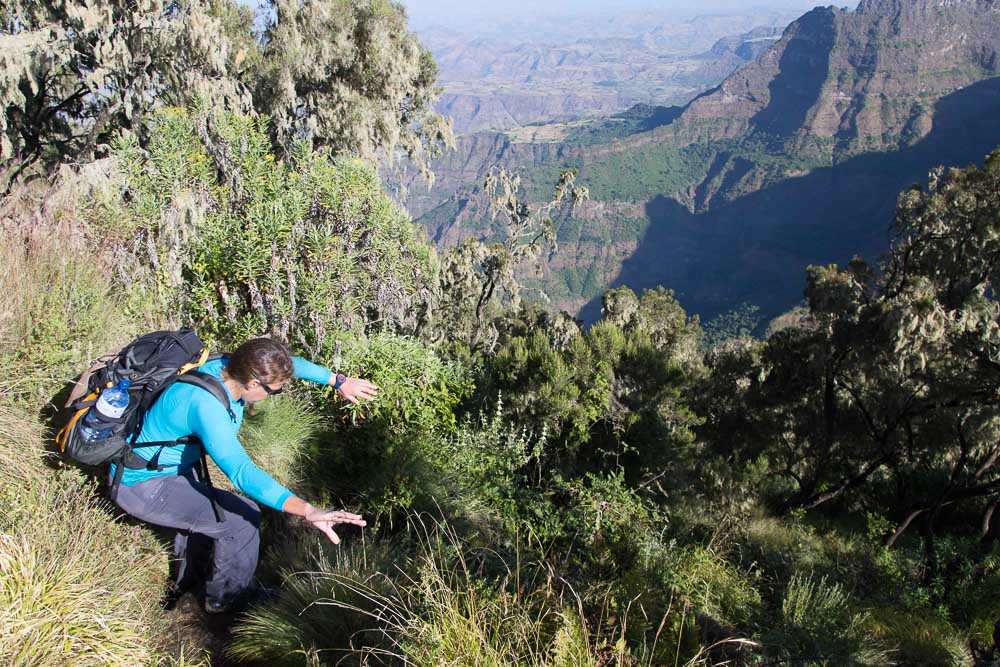
Don’t slip there!

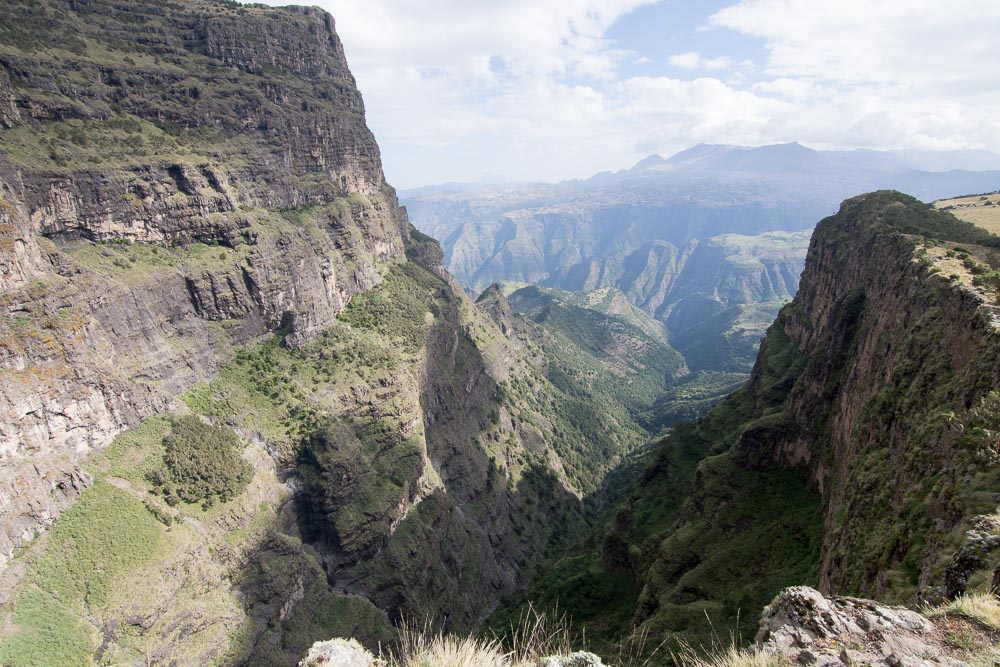
We were lucky to see some amazing wildlife too.
Friendly Gelada monkeys grazed (yes, they eat grass!) on the grassy hillsides. We learnt that, because Gelada monkeys are forever in the seating position as they graze, the females display their fertility through their pink chest plate – unlike other types of monkeys whose bums turn red.
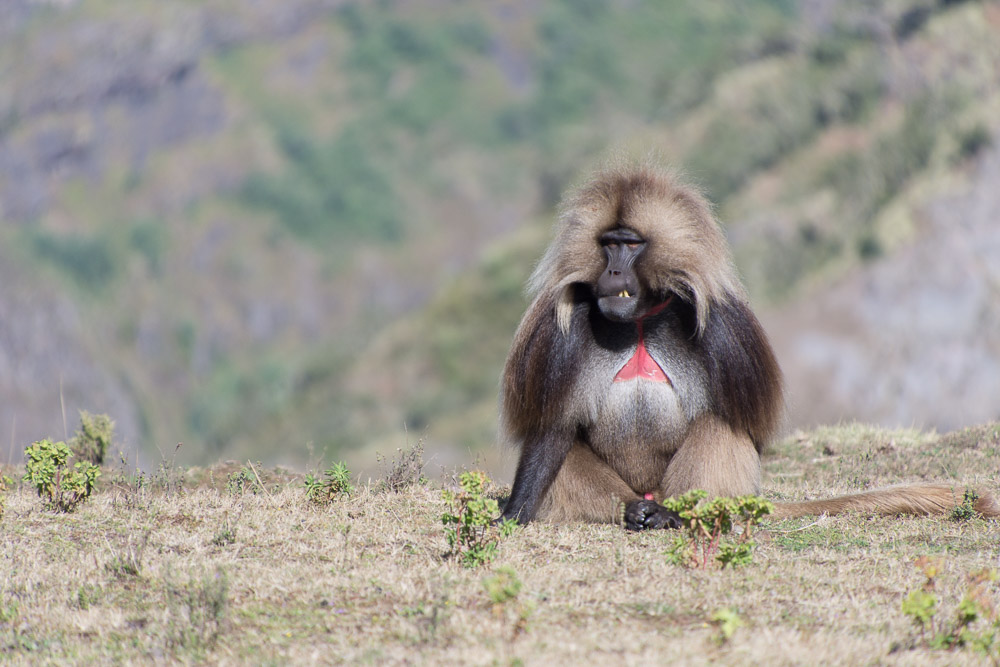
Gelada monkeys grazed on the hillsides
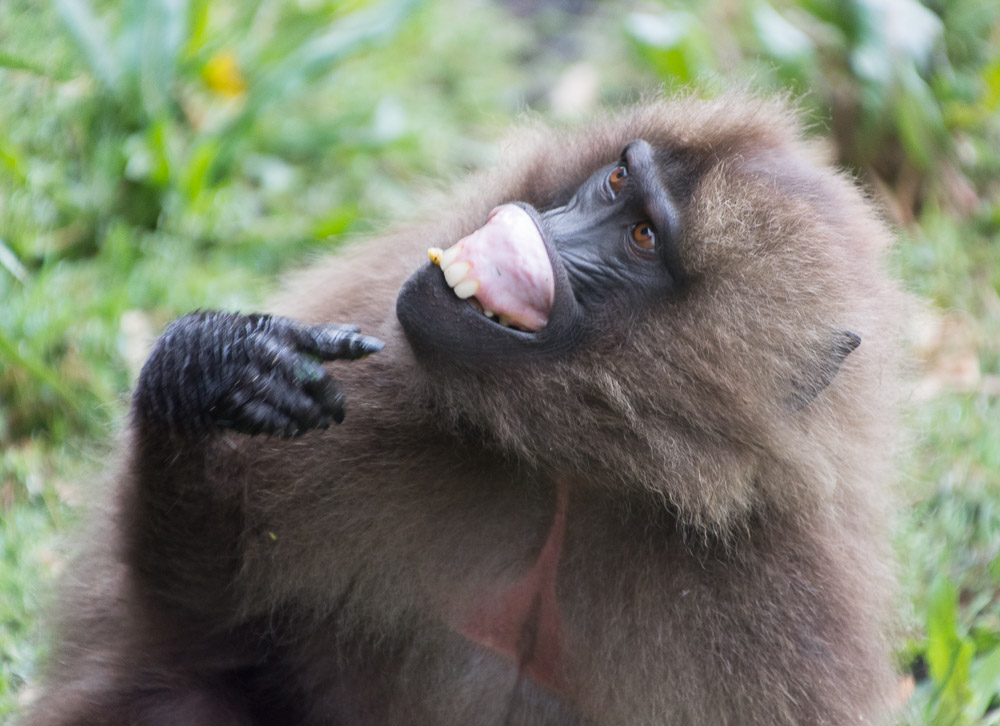
Gelada monkeys have ‘rubber lips’ which they retreat to reveal their teeth when they’re getting tetchy
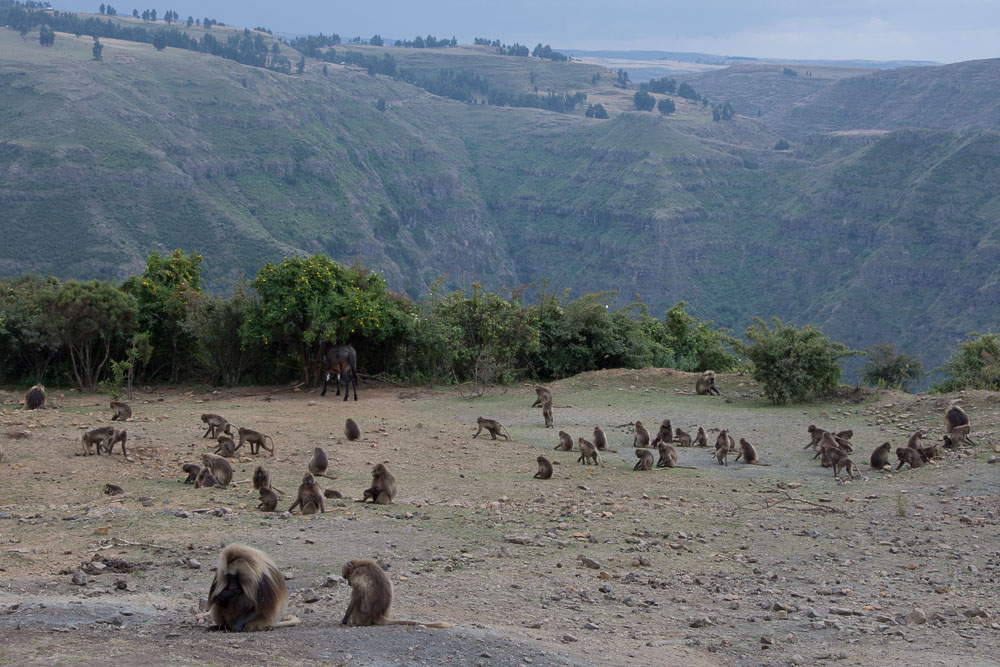
Gelada monkeys roam the hillsides
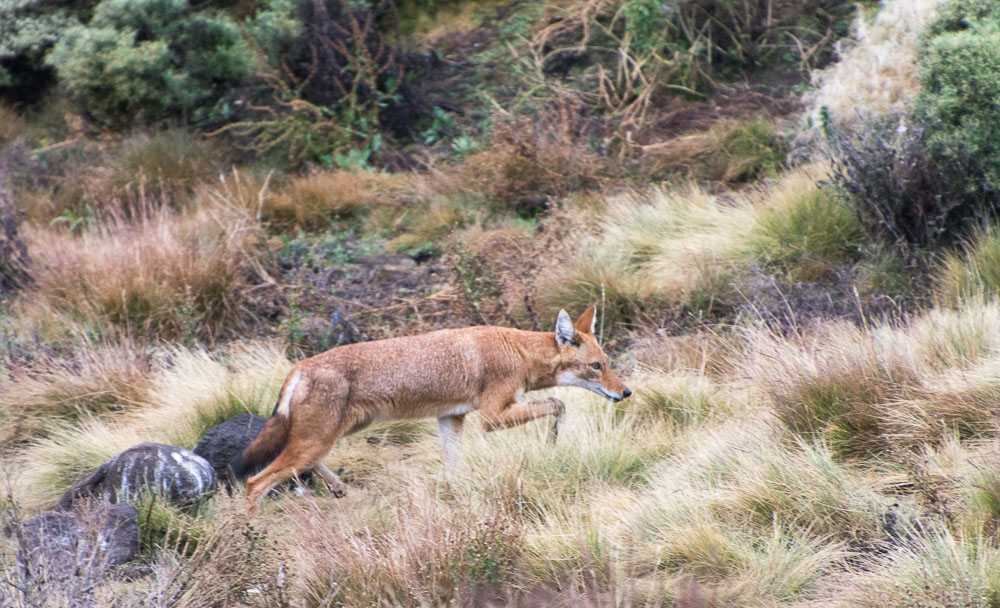
An incredibly rare sighting of an Ethiopian fox hunting for mice
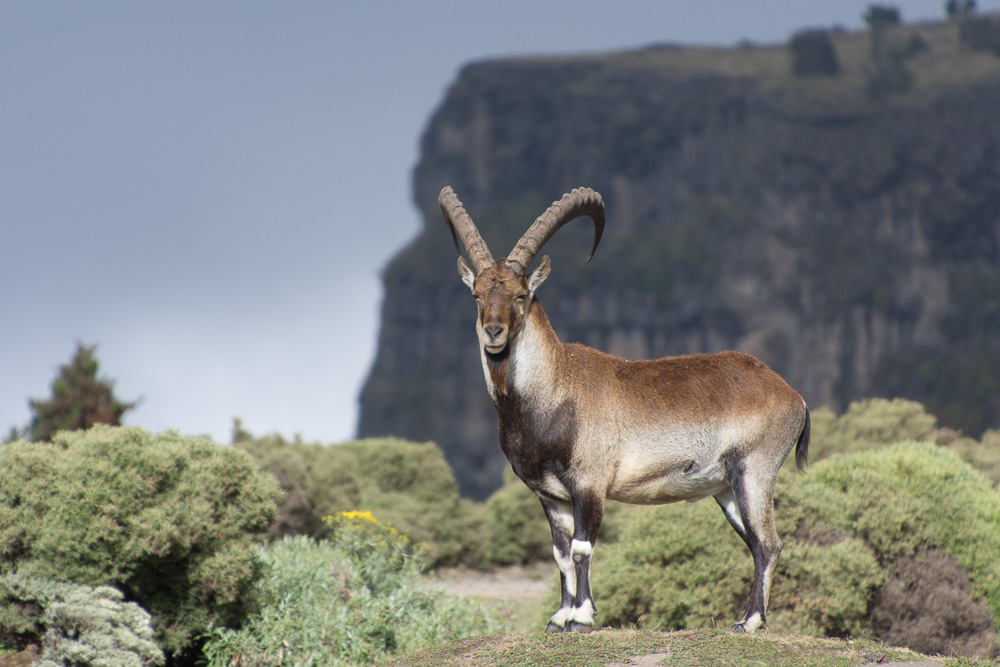
An ibex stands proud against the Simien mountains in Ethiopia
Additionally, we saw several ‘bone-breaker’ vultures. The diet of these huge birds consists of the bones of dead animals. If the bones they find are too big to swallow, they’ll pick them up and drop them from a huge height into the ravine below where they’ll weaken on impact with the rocks far below. They’ll repeat the process until the bones are of an edible size.
After months of pitching our own tent, it was pure luxury for us to arrive at camp after our days’ treks to find the tent pitched and flasks of tea and coffee ready for us. We shared popcorn with the ravens and watched the sunset from our high altitude camps – on the evenings it wasn’t tipping it down. In fact, we experienced our first rain since Romania over 3 months ago!
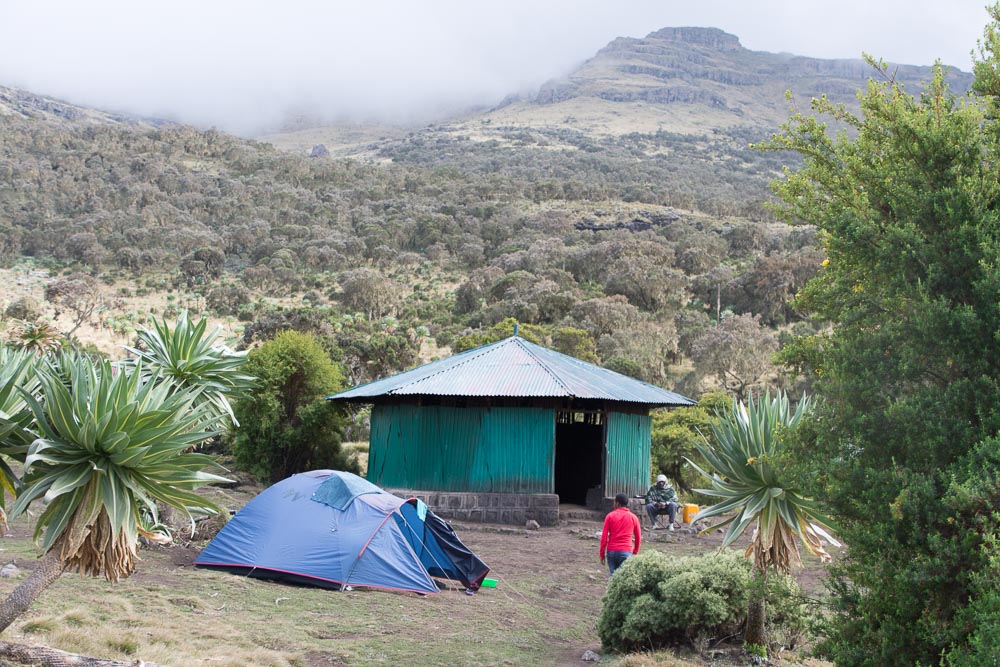
Although we missed the quality and spaciousness of our Vaude tent, we were happy to have a tent pitched for us each night
Our chef and assistant chef worked wonders too. They produced tasty, hearty meals from fresh ingredients. Our chicken meal could not have been fresher. In fact, I volunteered to help the assistant chef ‘prepare’ the live chicken for dinner. I held the feet whilst he used the knife.

Getting ready for a feast by the roaring fire
The temperatures in the Simien Mountains were in complete contrast to the 50-degree heat of the Sudanese deserts from where we’d come. We huddled round the fire to keep warm whilst eating and nighttime temperatures went down to freezing.
Although we were between 3,500 and 4,000 meters, the hiking itself wasn’t too strenuous and, with the aid of great food cooked up by our chef, we were able to get our bodies back to normal, ready for the cycling ahead.
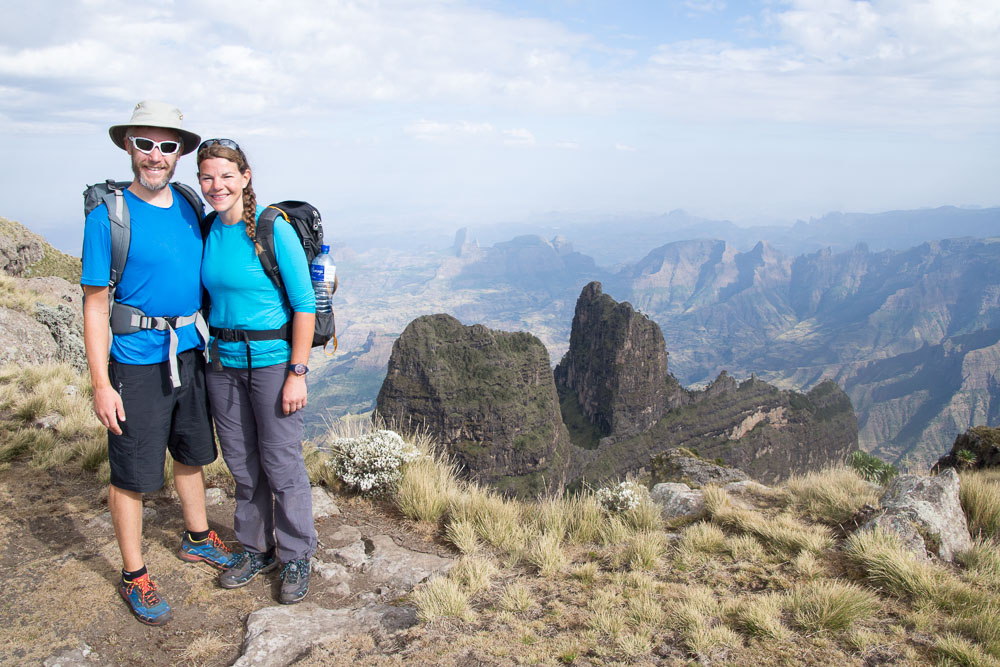
The Simien mountain views were stunning
On our last morning in the mountains we discovered blood spots on our sleeping bag liners and bites on our bodies. Back in Gonder we inspected our sleeping bags to find we’d picked up bed bugs from the bedding that had been provided on the trek. Not content with letting them fester, we’ve delayed our departure from Gonder to get the critters dealt with.
All being well, we’ll be back on the bikes tomorrow (Friday) as we take on the 800km cycle for Addis Ababa. A ride that’ll certainly introduce us to rural Ethiopian life. We just hope we won’t get stoned too much by the small children we’ll encounter: a real hazard of cycling in these parts. Please follow our progress on our live GPS tracker.
Don’t forget to subscribe to our email alerts so you’ll be the first to know when we’ve published a new blog post. We’ll never share your details. Ever.
8 of the strangest places we have camped whilst cycling through central Turkey. #7 was by far our favourite!
/in Kindness of strangers, London to Cape Town /by James DavisToo old to party in Passau
/in Danube, London to Cape Town /by James DavisI was looking forward to Passau. A beautiful Bavarian town steeped in history and, importantly for us after staying in some horrible caravan parks, the chance to stay in a beautiful riverside campsite where only tents were allowed.
We arrived mid afternoon and chose a fantastic position just by the waters edge and read our books in the last of the day’s sun as the river gently bubbled below the bank.
In high spirits we headed into town in search for a place that would serve a traditional stein and for a cheap meal. Hunger overtook before we could find anywhere that sold one litre lagers. Nevertheless, we’d given ourselves a rest day in Passau, so there’d always be the next night to find one.
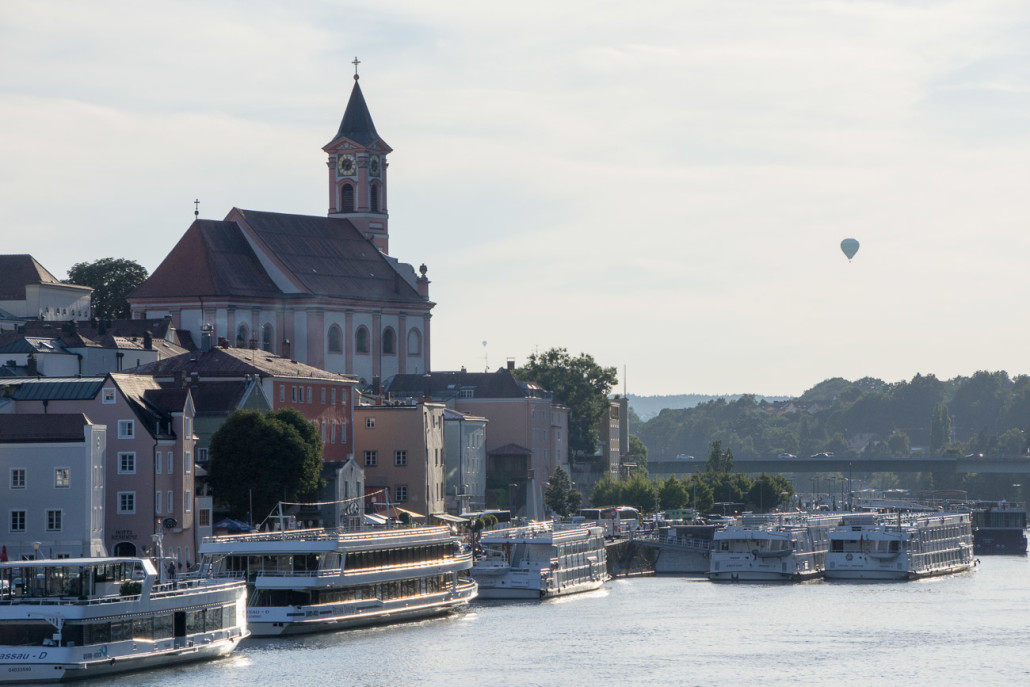
Beautiful Passau
We returned to the campsite after our meal to find that it had been overrun by ‘youths’. Tents were crammed everywhere and they continued to arrive.
We learned from a Dutch couple we’ve been meeting along the Danube that they’d been warned when checking in that tonight was likely to be noisy as there was a festival going on nearby.
In fact, there were about 4 lacrosse teams there. And, all of the blokes had a resemblance to the character Stiffler from American Pie. They were all pissed and, as we tried to sleep, more and more people arrived and the noisier it got.
Now, in years gone by, I may well have been tempted to join in and swig vodka from a 2-litre bottle and snort tequila through my eyeballs (or whatever they were doing) but, now that I’m an endurance athlete(!), a good night’s sleep was the order of the day and that’s not what I got.
The low point was probably around 3am when a further group arrived and decided it was a great idea to put up their tent less than a metre from ours, tripping over our guy ropes and singing as they put thier tent up.
The next morning, having barely slept a wink, Emily and I decided that, as last night’s antics were just the warm up to the next night’s proper party, we should reluctantly ask for a refund of our second night’s camping fees and find somewhere else to stay.
The trouble was, the campsite office only opened at 6pm so there was no clear way of getting a refund. That was until I spied a member of staff and asked her how I could get a refund. “Not possible” and “Come back when the office is open” were the replies to my request. Then I suggested either she or the café gave me a refund and when the man from the office returned that night she could get the money from him. A simple bookkeeping process one would think. However, my suggestion was met with (literal) shouts and screams of “This is not normal” before she finally stomped off, slamming the door in my face.
I returned to help Emily pack up the tent, asking her if she might be able to go and reason with the woman however before she had the chance (I think to Emily’s relief) the lady came bounding out of the office and, with tears in her eyes, threw (yes threw!) the 18 Euros at my feet shouting “this is my money! I work hard for my money!” before storming off.
Maybe we caught her on a bad day. Or, quite possibly, she hadn’t had any sleep either. Either way, we finished packing our tent and headed into town with an audience of bewildered campers wondering what on earth I could have done to provoke such a reaction.
The cathedral in Passau is claimed to house the ‘world’s biggest organ’. Now, there’s a confident boast for you. Realising the only real way to measure organs is with a tape measure, we sat on a bench outside eating our packed lunch and could only imagine the size of said organ as we heard a man playing furiously with it behind the cathedral’s closed doors.
We decided the best way to get a good night’s sleep was to cycle 20km downstream to a campsite that was marked on the map at Pyrawang, just over the border in Austria. As we passed the Austria sign, I released I’d not managed to have a Bavarian Stein, so it’ll have to wait until a visit to Katzenjammers upon my return to London next year.
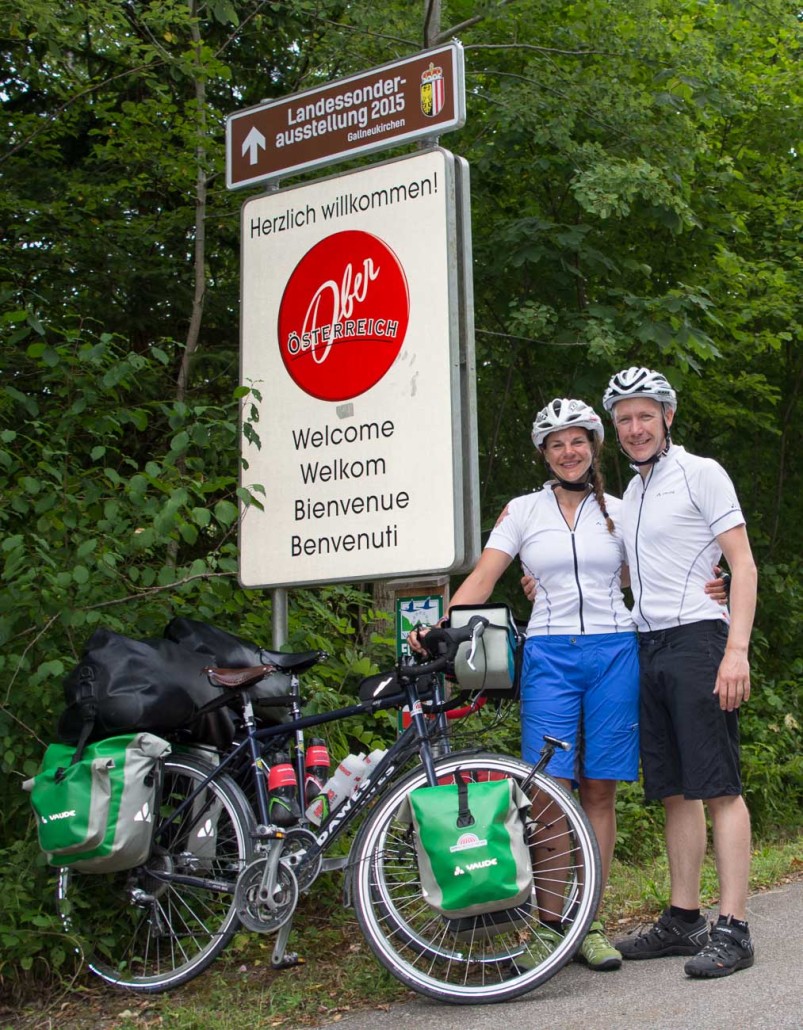
Crossing into our fourth country: Austria.
We arrived at the Pyrawang campsite at a time when they were setting up for an Ibiza-style ‘Danube beach party’ so we continued another 10km to find a nice little campsite alongside a marina at Hütt-Siedlung.
Here we met a lovely Austrian couple, Ilse and Manfred, who’d canoed all the way from Innsbruck and plan to navigate the majority of the Danube then pick up bikes and continue their journey into Georgia and on to Iran. They’re both teachers and we learnt that teachers in Austria can opt to receive only 80% of their pay for 4 years then take a year’s sabbatical in the 5th year receiving 80% pay. There’s no limit to the number of sabbaticals they can take. So, in effect, every 5 years you get a year off. This is a concept I may suggest to my boss when I’m back.
Just as we’d erected our tent the ‘youths’ in the caravan immediately adjacent to our pitch turned on their own Ibiza-style music to number 11 and started to get stuck into their Vodka Red Bulls and Jeagermeisters. Again, a (very) small part of me wanted to dust off my copy of Ministry of Sound’s Clubbers’ Annual 1996, get a 6-pack and pull some big-box-little-box shapes with them. But, as we’d left Passau a day early and continued an extra 10km to avoid noise, that thought was short-lived and I was, in fact, a miserable old git so went to get ‘someone in charge’ to tell them to shut up. Fortunately, the lady at this campsite was helpful and she told them to keep it down. The kids dutifully turned the music down but, as is the tactic for any party host when they’ve been told to keep the noise down, they gradually turned the volume up by one notch at a time until it was soon back up to 11 again.
We went to sleep with earplugs in. It then pissed it down so, for once, we were glad for the rain as they retreated inside.
Today (Sunday 2nd August) was soggy. We packed up our soaking tent in the rain. We cycled in the rain. And we passed through one of the highlights of the Danube (the river does a series of hairpins in a beautiful gorge) in the rain and sadly with clouds at tree height restricting our views.
Nevertheless, it was a mostly tranquil day by the grey Danube aside from an insect that collided with my face at speed and managed to sting me on impact.
After a day worrying that we’d be sleeping in a soggy tent, we arrived in Linz and I was astonished that Emily opted to camp rather than stay in a cheapish city-centre hotel room I’d found online. Exactly three weeks in and I think we’re getting the hang of this!
If you’ve enjoyed reading this blog post, please donate to World Bicycle Relief. Every penny goes to the great work the charity does in Africa – not to fund our expedition in any way.
Life on the Danube
/in Danube, London to Cape Town /by Emily Conrad-Pickles29th July 2015 | 1,399 km | Written by Emily
Germany is a country I knew very little about before leaving home, and it’s not heavily marketed to us Brits, so we don’t tend to visit much. I had visited Munich and a small place called Friedrichshafen on the Swiss border a few times for work, but other than that, if I am honest, it has never been a country on my “must-see” list. For this reason, I was both intrigued and excited about the prospect of spending 10 days cycling through the Black Forest and along the Danube River – to see some of Germany had I been missing.
We knew instantly we’d arrived in Germany when we bumped into a couple with bikes laden with VAUDE panniers heading to the bike paths within minutes of crossing the border. We were going to fit in here just fine. In fact, we’ve been the envy of many of our fellow cycle tourers when they see all of our great VAUDE kit – we’ve been stopped a few times now!
Our first few days in Germany were beautiful but hilly. I’m not sure Germany got the memo on mountain road switchbacks that we all dream about cycling up as roads have been straight with frequent 20-25% gradients, making it tough going when we’re carrying our worldly possessions with us. At times my heart was beating so fast I wondered if it might leap right out of my chest onto the road in front of me!
The Danube is the second-longest river in Europe. It originates in Donaueschingen in the Black Forest of Germany, and flows for 2,800km to the Black Sea in Hungary. Once a main frontier of the Roman Empire, the river is the lifeline to 10 countries from central to Eastern Europe. We have been tracking it for 10 days now, and it has not failed to impress.
The source of the Danube (Donauquelle) is an underground spring that is encased in a well outside a stately home in Donaueschingen. We went to take a look but, but it sadly was undergoing repair work. However, we took a moment to reflect beside the water that would be our route marker for around 2,500km. We were unsure what to expect ahead, but we were excited to get going.
From there, we left the concrete jungle, and the path took us offroad, on mainly well-managed gravel paths through a simply breathtaking gorge steeped in Geological history. Once upon a time, I would have been able to tell you more about the surroundings, but long-term memory fails me; my Geography teachers will be most unimpressed. We could not stop smiling as we made our way along the river alongside the other cycle tourers on their summer holidays.
A quick pit stop in Sigmaringen was our first taste of the beautiful towns that lay ahead; we celebrated with pizza and a beer before heading back to our campsite.
From there we headed to a town called Ulm where we were due to spend a day. Much to my excitement, it was also one of the only towns along the Danube in Germany that does not have a campsite, and so, by the time we realised we’d overshot the Youth Hostel by 5km, we were forced to stay in a hotel for a night. A mattress meant my first proper night’s sleep since Alsace, and it was pure bliss.
Ulm is a stunning 12th-century town on the riverbank full of hidden gems around every corner. Apparently, it has the tallest church spire in Europe. It was undoubtedly impressive; walking around the streets felt more like I was in an Italian town than a German one – why had I never heard of this place? More was to follow with the following few towns we passed – all should go onto a holiday visit list – Donauworth, Ingolstadt and the most impressive of them all, Regensburg.
We’ve slowed down a bit since France to allow us to enjoy the surroundings – we don’t want to miss anything – cycling for 4-6 hours a day instead of 8-10 hours has made a real difference. However, it does not take away some excellent moments that only tiredness can produce, such as James getting on his bike backwards and I lost my sunglasses for a good 10 minutes before finding them on my head.
Regensburg is the oldest town in Germany and the old capital of Bavaria. We checked into a campsite for a couple of nights to spend a day looking around the city. In Bavaria a can of beer costs 40p – around half the price of a can of coke. As my Grandpa would have said, “It would be dangerous not to”, so we enjoyed a few beers and cooked a feast at the campsite and enjoyed a rare a lie in the following morning before heading into town.
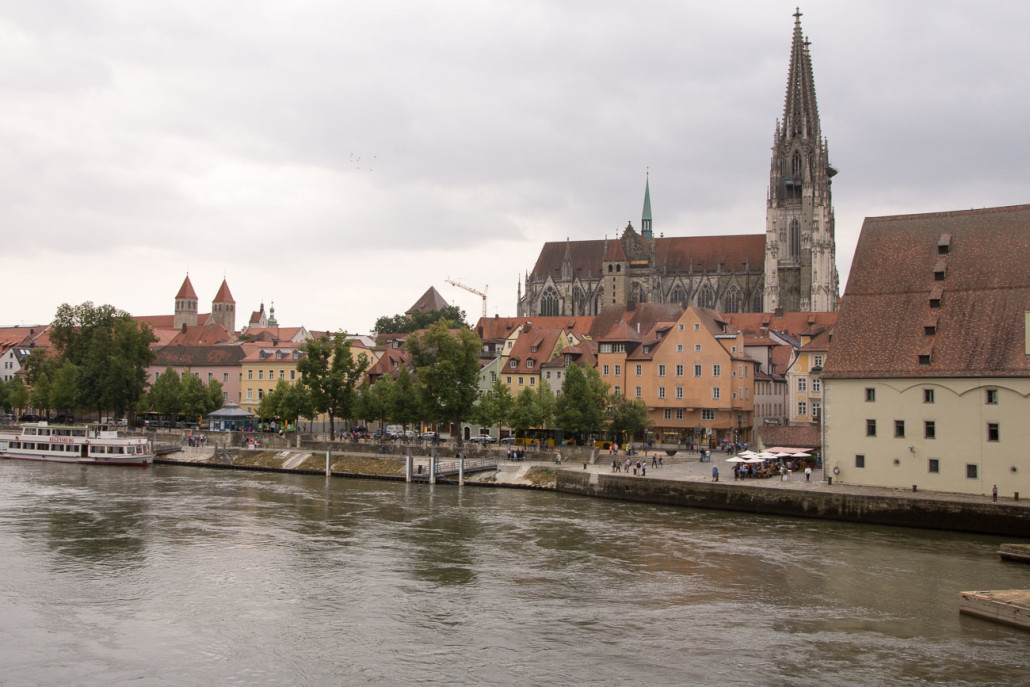
Regensburg
Naturally, being a rest day, it rained nearly all day, but that did not take anything away from how magnificent Regensburg is. The cathedral was a highlight, dating back to pre-1100; it is home to world-famous medieval stained glass windows dating to 1230.
We are currently around 60kms (and one puncture) further along the river in another charming town called Straubing, again home to a beautiful church and an idyllic walled town centre with cobbled streets lined with cafés.
Before you ask – no, sadly, we are not wining and dining in all these towns as budgets do not allow. But it’s been an absolute privilege to travel through them and experience their beauty with a packed lunch!
We have been camping on and off for nearly 3 weeks and are now into a routine. James has almost managed to work out how to pack his panniers in under two hours every morning whilst I have time to dismantle the tent, have a shower and do my nails :-). It was with much excitement that, 5 nights ago, we finally worked out how to put our tent up properly. We have been enjoying some good sleep and making the most of German campsites with hot showers and fresh water as we are fully aware that, before long, these luxuries will disappear.
So, naturally, being the man, James is in charge of fire and map reading (for those who know me well, you will all agree that both these things are good responsibilities for me not to have; otherwise, we’d have burnt down the tent and be cycling towards Norway). I am mainly responsible for the relatively safe kitchen duties; chopping vegetables and washing up. And no, I have not cut my fingers off with a knife yet!
It’s safe to say, we are having the time of our lives and loving every minute of this adventure so far. We’ve met some great people along the way already. I don’t think we will ever get tired of seeing people’s expressions when they ask how far along the Danube we are going, and we tell them we’re cycling it all and then continuing to Cape Town. It’s been especially great to meet so many families out here, all cycling together – some with kids as young as 2 years old.
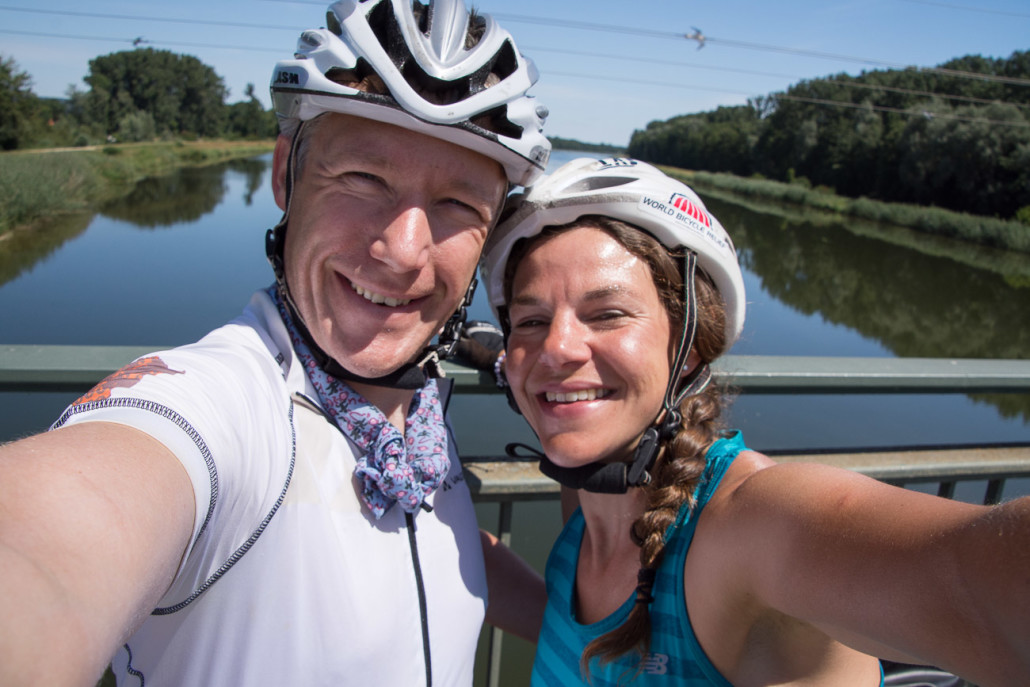
Smiles by the Danube
Germany is as slick and efficient as you might imagine. We’d highly recommend it as a place for cyclists to visit – whether on touring or road bikes. The national bike paths are incredibly well signposted and take you to some unbelievably beautiful places, and nearly every major road has a cycle path alongside it. If you fancy cycling for a week or two without any cars, this is the place to come!
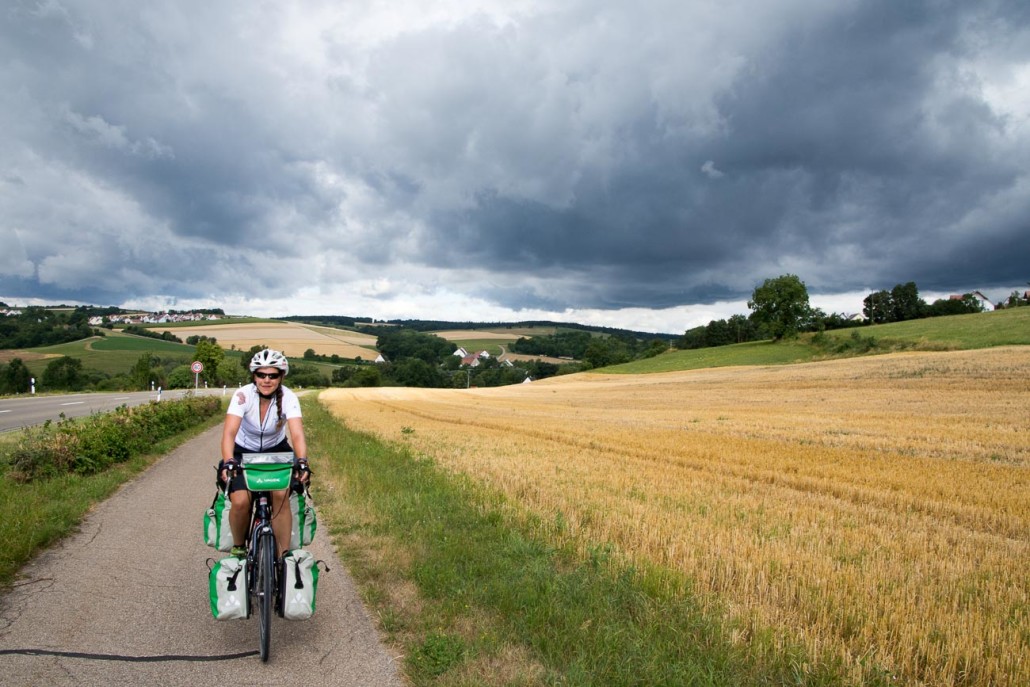
Tomorrow we head about 110km further along to our last stop in Germany, Passau, which is meant to be Germany’s answer to Venice. We shall mark our last day in Bavaria with a Stein, a few sausages and some Sauerkraut. After that, it’s on to Austria, and we hope to be in Vienna by next weekend.
Thank you, Germany; we can’t wait to come back again someday.
If you’ve enjoyed reading this blog post, please donate to World Bicycle Relief. Every penny goes to the great work the charity does in Africa – not to fund our expedition in any way.
Feeling the heat in the first week
/in Danube, London to Cape Town /by James DavisJuly 21, 2015 | 898 km | By James
For the few months before we set off to cycle from London to Cape Town, I had imagined the first week on the road in great detail. We would both gently amble through the French countryside, the sun gently warming our backs, we’d get the day’s miles done by noon, allowing for ample time to kick back and relax after the last few hectic weeks before we departed. I imagined I’d have Tweeted every hour, written a blog post every day, stopped to take enough photos worthy of winning the Travel Photographer of the Year, and I’d be well into the second book on my to-read list by now.
In reality, our daily mileage has been high, our days long, we’ve battled heat fiercer than anything we were expecting in Africa, photos have been snatched from the side of the road, and we’ve arrived at our days’ destination late (both having a remarkably similar odour and saltiness to the camembert we bought one lunchtime that slowly baked and disintegrated in our panniers all afternoon) and with only enough energy to find a bed for the night or pitch the tent and with mouths as dry as our dust-filled cycling sandals.
Ten days in, and I still haven’t made it past the first chapter of my book. I’ve had to re-read the same page three times as my eyes have involuntarily closed at each attempt, and our sleep has been interrupted by round-the-clock harvest vehicles, church bells and even wild boar surrounding our stealth camping spot in the middle of the night.
Our first week has been hot. Very hot. Temperatures have been at or over 40 degrees all week, making cycling over undulating French countryside with fully-laden panniers incredibly tough and slow!
After crossing the channel courtesy of DFDS Seaways, we landed on French soil very early on Bastille Day and followed the Avenue Vert and country lanes to Beauvais. As everything was closed, we picnicked in our cheap hotel room.
We rose early the next day and followed quiet country lanes through wheat fields towards our destination, Villers-Cotterêts. There, as we stopped for a chilled Coke in the town square dedicated to Three Muskateers authors Alexandre Dumas who was born there, the temperature on our Garmin topped 43 degrees. That night, we headed deep into the Retz Forest and found a quiet spot to pitch our tent. The forest’s described as “home to a wonderful variety of fauna including deer, rabbits, hares, foxes, pheasants and even wild boar.”
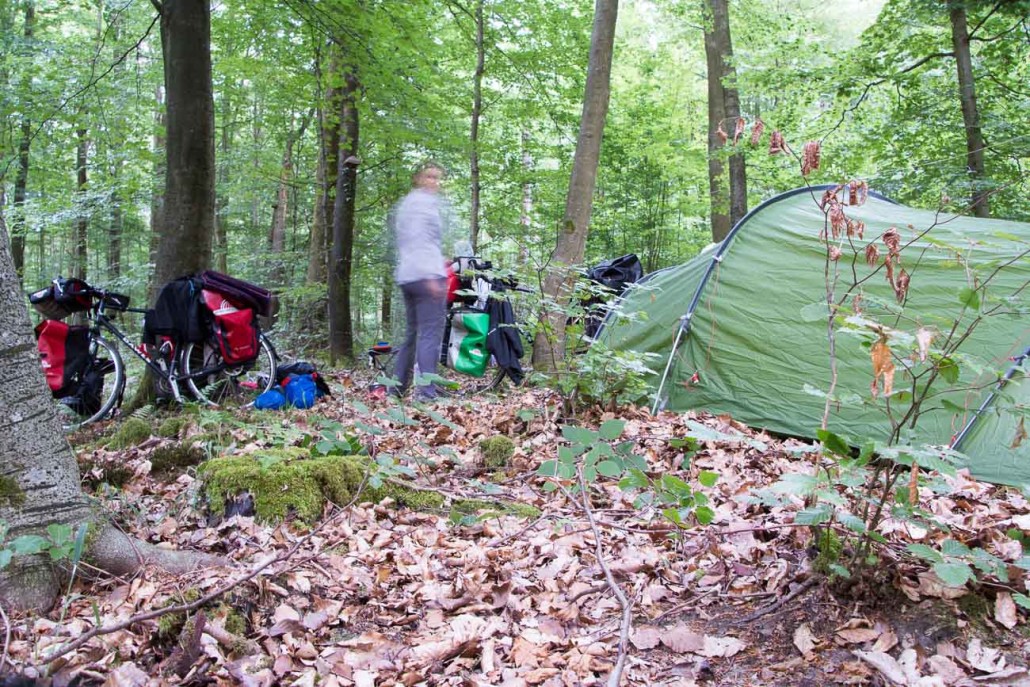
Wild camping in the Retz Forest – before the wild boar surrounded us at night!
As we cleared our cooking equipment away, a large deer wandered by in the distance, making its distinctive call into the empty darkness.
“What’s the hell is that!” Emily grabbed my arm and jolted me from my deep sleep. “They’re coming!” with panic in Emily’s voice. Listening, I could hear the rustling of the leaves coming nearer and nearer. I urged Emily to keep quiet. We both lay rigid as, closer and closer, movement in what would otherwise be an empty, dark and lonely forest came nearer. There was a grunt. “Wild boar!” Emily whispered.
These potentially dangerous beasts were now surrounding the tent, millimetres of fabric between us, our food and their sharp tasks. They grunted, sniffed and rummaged in the foliage around our tent whilst we lay, hearts pounding, daring not to make a sound.
We’d tied our rubbish up in a tree, so, after finding our presence didn’t bring any food source outside our tent, they finally continued their way through the forest. It was almost impossible to sleep after that; every movement of a leaf would make us bolt upright.
Our third-day cycling in France was also a scorcher, but it was fantastic to cycle through the vineyards of the Champagne region. Epernay was our destination but, champagne was the last thing on our mind by the time we arrived; we would have happily paid champagne prices for jeroboams of tap water.
After Epernay, we had a long 85-mile day, which mostly followed a canal-side bike path. After a very long and tiring day, we struggled to find a camping spot, so we asked some villagers if they knew anywhere to pitch our tent. We were astonished and incredibly grateful to Marylène, who invited us to camp in her garden. She offered us showers, drinking water and even vegetables from her garden!
As we left the flat bike path behind the next day, we cycled 93 miles over very hilly terrain. We reached our wild-camping spot by a lake exhausted and were munched by mosquitos and red ants as we cooked in the dark.
Emily’s brother, Jeremy, joined us for the next day’s cycling. Although our handicap of panniers ensured the pace was slow as we climbed over the North Vosges Mountains to Alsace. It was fantastic to meet Jeremy, Marie-Agnes, Laurie-Anne, Lawrence and Richard, and they looked after us incredibly well over two evenings and a rest day.
It was a special moment when 6-year-old Laurie-Anne joined us for the first few KMs of the day from the family home in Bergbieten. Again, it was sweltering as we spent a very long day in the saddle as we gradually climbed up to Triberg in the heart of the Black Forest, where our efforts were ‘rewarded’ with the display of the ‘world’s largest cuckoo clock’.
After so many punishing days in the saddle, we decided we needed a shorter day. Apart from two horrifically steep climbs to the ski slopes above Triberg in the morning, it’s been a descent to tonight’s campsite at Donaueschingen; a town that sits at the source of the Danube; the river we’ll be following for the next 2,500km or so!
Take a look our the London2CapeTown Facebook page for more photos!
If you’ve enjoyed reading this blog post, please donate to World Bicycle Relief. Every penny goes to the great work the charity does in Africa – not to fund our expedition in any way.
The countdown begins – and the nerves have arrived!
/in London to Cape Town, Preparation /by Emily Conrad-PicklesIt’s now less than 6 weeks until we begin our cycle from London to Cape Town, and it’s a good time to start our blog.
I’m not sure where the time has gone. I remember it being February and packing up our things to take to the London Bike Show and thinking – “hurry up, July, I want to leave!” And now, as I sit here, panic is beginning to set in slightly as the reality of what we are attempting is dawning on me.
There is still so much for us to do. The last few weeks have been completely rammed. We are both still working full time and have busy work schedules, so we have to fit everything into our evenings and weekends. But, slowly, we are getting there. From wilderness first aid courses, practice bike rides, route planning, kit checks, planning our fundraising schedule, and organising our London to Brighton cycle ride, it has been a busy few months.
We are so excited about the expedition and hope many of you will follow our journey along the way. We are lucky enough to be using the same GPS tracker that Mark Beaumont used on his recent epic World Record-breaking Cairo to Cape Town cycle – supplied by Trident Sensors. Once we set off, our location will be updated daily on a link via the route section of our website. But, do not be fooled; we will not be travelling at Mark’s speed or daily distances, so you will need a little more patience to track us.
We plan to share our journey as often as we can – so you can experience the journey with us. We’ll also be blogging each month on Total Women’s Cycling where you’ll not just be able to read about the trip but also find out about the kit and equipment that our generous kit sponsors have provided us.
A huge thank you to everyone who has helped us get to where we are today – a particular mention must go to Chris Davison at Vaude, who has pretty much kitted us from head to toe in the best cycling and camping equipment for cycle touring. Also, to our family, friends, and colleagues who have all helped us get to the start in some way or another. You’ll hear more about them along the way.
Thanks also to Sea to Summit, Victorinox, CamelBak, Click Stand, Goal Zero, DFDS Seaways, Involution, and Thrive. They have all supplied us with valuable equipment and services, which we’ll blog about in due course.
In the meantime, please Like our Facebook page, follow us on Twitter and, if you haven’t already, sign up for our London to Brighton Charity bike ride on July 12th.
Emily

